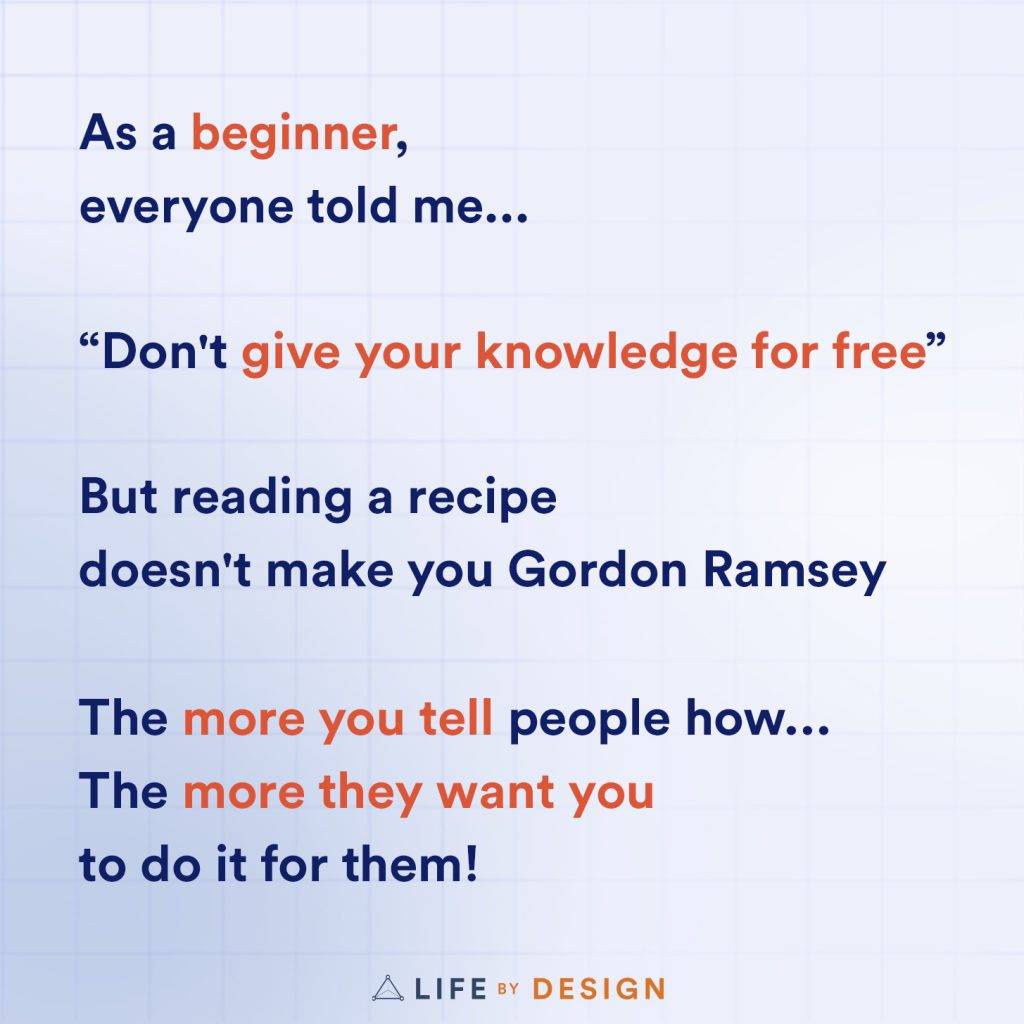I'm building the best in-depth library of real FAQs from Solopreneurs
"should I show prices on my website or hide them?
If your services are simple,
lots of people want your services, And you don’t have enough time to speak to all the people that want your services…
Show your prices,
Which wil vet out bad fits early.
If your services are complex, And you want to sell them for a higher price, And price isn’t the most important decision factor to your customers…
Hide your services,
Until you’ve had a proper conversation about goals and values.

- — from Anon
- Read full Q&A
"How do I talk about my pricing as a freelancer?
❓ “What if the client say no?”
They might. Not everyone will be onboard.
But if you are maxed out on time, then you have scarcity.
Sometimes you outgrow your clients and have to clear house to make room.
Extreme example:
If you were to double your prices but lost half your clients,
You’re making the same amount of money with half the effort.
The more you want the sale, the less likely you are to get it.
Go into every sales call with the attitude that you don’t need the job. The outcome is out of your hands.
Now you can act as an advisor, instead of selling to them.
❓ “How much do I raise my prices?
“I don’t want to be greedy, but I don’t want to miss out!”
The number differs for everyone.
A rule of thumb: your prices should feel a bit uncomfortable.
Test it:
Try a small raise to gauge reaction, and increase from there with the next conversation until you start to hit resistance.
If you have a troublesome client, you can take a bigger risk:
Pitch a large jump to see how they react,
If they don’t accept, then you’ve lost nothing.
If they do, then you could be raising your prices more than you think.
❓ “What if a retainer ends up more work than hourly?”
Be careful to set caps on your packages, define how much is included, what’s not.
Always give the client an opportunity to upgrade if they need more.
I usually assume they want a middle package, and ask “is that enough for you?”
❓ “How do I bring up raising my price?”
No-one likes talking about prices.
But the road to success is full of awkward conversations.
There’s no way to pitch with 100% confidence.
If you haven’t updated your prices in the last year, I guarantee you’re not charging you’re worth.
This doesn’t go away.
When I get a yes I wonder “Could I have charged more?
When I get a no I wonder “Was it too much?
✅ Bring it up over a call so you can gauge reaction.
✅ Explain why, emphasize your value, pitch with confidence, ask if they are still onboard, wait for the response.
✅ Have your packages and pricing prepared, but be prepared to tweak them on the fly.
✅ Prepare answers to all possible objections in advance
✅ Be ready to move them to the new payment method on the call.
✅ Be prepared to get a no.
Check out my full guide to pricing as a freelancer
Here’s tips on setting prices as a freelancer

- — from Various
- Freelance coaching
- Read full Q&A
"Should I just do what the clients says, or push back and do what’s best for the client?
This is a great question!
basically:
It depends! 🤣
We should always service clients, not just serve clients.
as the expert it’s our job to advise as an expert.
sometimes that means saving clients from themselves.
People are always biased to support their own opinions over the expertise of others.
it’s the bane of all professions:
If the client doesn’t see you as the expert, then they will doubt your opinion more often and trust their own more.
I personally think it’s our job to help the client.
But obv there’s a limit to this.
“you can a horse to water but you can’t make it drink”
Ie you can advise the client what’s in their best interest, but at the end of the day you can’t force them to take your advice.
So long as in my heart I know I’ve done my best to help,
then I can be satisfied I did the right thing.

- — from Paolo
- Web developer
- Read full Q&A
"Should design agencies use ai to design or refuse to support it?
“I refuse to support or use ai for design, Also, based on this poll alone…It doesn’t look like people who adopt it will have very good sentiment towards them from the majority of the actual talent out there.”…
this is a bit like protesting against the steam engine.
It’s happening people.
Refusing to acknowledge technology advances won’t change anything.
Refusal to participate won’t stop that train,
Get on board or get left behind.
If you feel threatened ask yourself how you would feel about a designer that refuses to use Photoshop, and sticks to pen and paper
You’d think: “what a dinosaur”
Good design should serve a purpose.
Rewards will be distributed depending on the effectiveness of results.
Ai is just another tool to produce a result.
ai provides leverage in terms of reducing labour.
Sloppy work will always be sloppy work,
no matter what tools you use.
Good work will be good work.
If people using ai are providing good results,
I doubt the customer will know or even care how it was produced.
If designers have a poor sentiment to other designers using ai,
Then I’m disappointed in them.
Their negative sentiment will have zero effect on designers using ai, so long as they are getting clients good results.
Over time, more progressive designers who continue to evolve their tools and skillset will secure better clients and more opportunities,
Which I imagine might embitter designers refusing to use ai even more,
However it won’t have any impact on the success of the progressive designers.
That’s just the nature of a free market.
The direct output of ai generated won’t compare to original creative work.
But there’s also some pretty beautiful stuff out there which has been created by ai then manipulated and refined.
If using ai makes you unprofessional, and untalented, by your logic…
People who use assets from Adobe stock are talentless because they didnt take the photography themselves.
website designers usung WordPress should have coded the CMS by scratch.
Clearly this isn’t true,
And the idea of judging other designers for using ai would be highly entitled.
AI is often used for ideation, feedback, inspo, editing etc.
It’s a broad spectrum in a creative process.
AI still falls flat when it comes to any fuzzy logic, or anything strategy related, but that doesn’t lessen the talent of designers who use it.
AI reduces the labour input.
The mind that imagines, guides and refined is still the talent.
But on a more human level as designers,
Our goal should be to lift each other up,
not hold each other back or put each other down.
Ai is just another tool to produce a result.
Use it to do good work which provides more value for your clients.

- — from kennon
- motion designer
- Read full Q&A
"How do I deal with clients who keep sending lots of revisions in lots of emails after I’ve already started changes?? It’s so annoying!
Do you have a client who likes to trickle in additional revisions after you’ve already started the changes?
I call this “nibbling”.
The client is not deliberately trying to infuriate you, they just aren’t organized.
But we must draw a line in the sand on what will be included, and what must be billed for as an additional round of revisions.
An analogy for dealing with clients who “dribble” their revisions…
Picture a group of people waiting at the bus stop.
People trickle in at different times, and wait for the bus.
The bus arrives, and everyone gets on, and the bus leaves with everyone together.
The bus may wait a few minutes for a few stragglers,
but once the bus has left, it’s left, it’s not coming back.
Anyone that misses the departure will have to wait for the next bus.
As the client trickles in their revisions, you keep a collated list of all changes,
and let the client know when the changes will be actioned,
and that after that cutoff, any additional changes will be billable under a new round of revisions.
Every project and task has a fixed number of revisions, to prevent scope creep,
and to stop clients from “nibbling” by requesting changes one at a time.
We manage number of revisions by…
A telling the client how many rounds of revisions they have
B Compiling multiple requests for changes into formal “rounds of revisions”
Think of each as a checkpoint in our process.
We use rounds of revisions to “draw a line in the sand” on completed work,
so that the client can’t keep drip-feeding unlimited requests without consequences.
Setting a fixed no of rounds forces the client to collect their thoughts and be more concise.

Power freelancer move:
Take your most disorganized, technophobic client
(“Sorry I’m not good with emails haha”)
make them aware that disorganization will cost more,
watch them magically get organized and learn how to use email!

- — from Paolo
- Freelancer web designer
- Read full Q&A
"Growing a freelance business is like trying to sail a boat in stormy seas. What advice do you give? ⛵️
If I may offer something that helped me:
The diagonal of your life:
Stop trying to wrestle your life into submission.
Focussing on the end results and struggling harder will just result in burnout.
Set a general direction, create habits which steer you in that path,
but let go of controlling the exact trajectory.

Here’s a few tools which helped me:

- — from Mary Beth Hazeldine
- Freelance Consultant
- Read full Q&A
"I’m feeling discouraged today. How do you deal with self doubt?
I feel like I don’t have the qualifications. Like I don’t really know what I’m doing. I’ve never worked for a company doing any of the things I offer. I see plenty of people who are successful with less qualification than me, but I also see a lot more. I guess I’m comparing myself. – Alana, webflow designer
As someone who’s burned two degrees, qualifications are overrated!
Best to learn is by doing.
Sometimes that means selling stuff you are not sure how to do yet.
But you’ll figure it out!
It feels uncomfortable and scary, which is never nice but that uncomfortable feeling just means your in the growth zone.
It’s easy to compare yourself to others If your on social media you can’t avoid it.
But remember everyone has their own pace,
And most of the stuff you see on social is the cherry picked highlights anyway.
It’s always hard then you get a little win which gives you the energy to keep at it.

- — from Alana
- Webflow designer
- Read full Q&A
"How much should I charge for SEO services as a freelancer?
SEO Pricing Structures
In terms of SEO pricing and structures, everyone has their own approach. Personally, I’ve worked with SEOs who charge varying rates and have different structures.
Generally, I prefer to charge a flat monthly fee. It’s the simplest way for clients to understand. Introducing one-off costs and hourly rates can confuse clients and lead to constant back-and-forth discussions.
I typically set a fixed monthly budget. In the first month, I focus on on-page optimizations. From the second month onward, I concentrate on link building. However, I do let clients know that some of their budget may go towards on-page adjustments throughout the ongoing process.
Communication is Key
It’s crucial to communicate to clients that SEO is a long-term strategy:
It’s not a quick fix or something where budgets can fluctuate monthly based on their bank balance.
I usually require a minimum three-month commitment.
This helps manage expectations since many clients might expect results immediately and may not understand that the work takes time to produce results.
While you can’t enforce contracts strictly, having this structure provides a foundation for your work.
I usually charge a flat monthly fee via direct debit, with an invoice sent out each month.
Reporting and Performance Tracking
Clients also receive a monthly report via Loom.
I track keywords and their domain authority, which are good indicators of performance.
Remember, traffic can vary due to seasons, weather, and personal preferences, so traffic isn’t a reliable indicator of performance.
Setting Rates for SEO
SEO pricing and rates can vary widely. You’ll find both cheap and expensive rates, and professional SEO consultants who get results can charge £500/hr.
Your comfort level in charging will depend on your experience.
If you’re new and lack confidence in your results, it’s reasonable to charge less.
Many gurus advise doubling your rates, but if you’re still learning, it’s better to charge what feels right until you build confidence in delivering results.
For example, I’ve reached a point where I can confidently charge £££ if I believe I can generate significant leads for a client.
If you’re still learning, treat it as a paid learning opportunity and charge less.
Minimum Charges
My minimum fee for SEO services starts at £800 a month.
This is for basic packages, including some on-page tweaks and ongoing link building.
Lower budgets, like £200 or £300 a month, often attract clients who lack the long-term mindset needed for SEO.
They tend to quit after a short period and may request refunds, so I avoid those lower-budget projects.
However, if this is your first project with someone you know and trust, it might be fine to negotiate a lower rate.
Understanding the Value of Your Work
When budgeting, consider your time and expertise.
The insights you provide can significantly impact a client’s strategy.
For instance, if a client is spending £2,000 on Linkbuilding without guidance, they might not achieve good results.
However, spending just 10 minutes analyzing their keywords can deliver £100’s of value,
So your rate for strategy can be in the hundreds of £ per hour.
Whilst lower value activities like actually implementing the onpage changes you’ve suggested may be charged lower.
SEO Pricing Strategies
For link building, consistency is key.
You can source links from various platforms like Fat Joe or Fiverr,
or link from your own personal network of sites.
Determine your link costs and add a markup for administration and profit.
If you’re unsure about a client’s potential, consider charging a one-time fee for necessary on-page work before starting link building.
The main thing is to communicate clearly with your clients about what you’re doing and why.
Client Communication and mindset
Transparency is essential, especially when results may not show immediately
Regular check-ins and updates—bi-weekly, for example—can help maintain client trust.
Explain any lack of movement in rankings and discuss what to expect moving forward.
Ultimately, for SEO, a client’s satisfaction with your communication and the work being done often matters more than immediate results.
Calculating Value
Estimate the potential ROI based on keyword rankings, traffic, and conversion rates.
If you’re struggling to figure out your pricing as a freelancer, assess
- how many leads your client gets
- what that lead is worth over a year
- How many more leads can you get them
- Work that backwards to how much you can charge.
For instance, if you can rank position 1-3 for a keyword with 1,000 monthly searches,
you could get 10% of that traffic.
If the website converts 10% of that traffic into paying customers,
then you could get the client an estimated 10 monthly customers every month.
If a customer is worth £1000 over a year, then you’ve just made them £10,000/yr
This is all just very rough estimates,
But you can use these numbers to demonstrate return on investment.
Related Resources

- — from Craig
- Designer
- Read full Q&A
"What do I say if my client always wants things done immediately?
Rush jobs are always a shitshow.
Rush jobs usually happen because of poor planning and organisation.
This will have a negative effect at all points in the project.
Then the client gets annoyed that you missed the deadline, even though it was THEM that stalled for 4 weeks. 🤬
Make sure when giving deadlines you highlight that the timeline is based on their feedback and adjust the timeline as you go.
Sometimes clients don’t plan ahead, leave it to the last minute, then try to force you to pick up the pieces.
The customer’s lack of planning does not make it an emergency for you.
If you don’t get information or feedback you need to proceed it delays the project,
it’s your job to make sure they know this in advance.
If they stall for 2 weeks on feedback, it pushes the timeline forwards 2 weeks.
If we let clients dictate what we work on and when, it’s a recipe for burnout.
We’ll endlessly be jumping from task to task, firefighting from our inbox as clients fire over emails with instructions whenever a new thought occurs to them.
Sometimes things come up.
If they do have a genuine rush like a product launch etc you can say something like:
“no problem, it’s a tight turnaround but we can make that deadline for you. But we’ll need to pull out all the stops, put some of our current projects on hold and do overtime to achieve that so our standard rush charge of 20% will apply. Just let me know how you’d like to proceed?”
(You can also mention unsociable hours charge if they want you working outside reasonable work hours)
clients need to remember people are people. I think people often forget that when they are at their keyboard, the person on the other end of your email is a person, not a robot they have work hours breaks, personal emergencies etc.
Nipping this stuff in the bud will force them to adjust the relationship to a more respectful one.
however needs to be done carefully, and with subtlety as they are still the ones who pay the bills haha.
The key is don’t lose your temper or get annoyed, just state facts, have emotionless template messages like the above that you can send when the client is being unreasonable.
They may not realise that this expectation is unreasonable if they aren’t aware that you have many other clients all wanting their own tasks done as quickly as possible.
So we will have to politely and calmly adjust their expectations on deadlines, by explaining “The Work Schedule”.
Use your work schedule or queue to balance workload effectively.
The client will never know what your schedule is,
But they will understand that you have to work on tasks in an order.
“I’m afraid I won’t be able to action this immediatley, as I have a few other things in the work queue before this. I’ve bumped you up the work schedule as much as I can already;
But to be fair to my other clients I must respect the work queue,
After all, you would be annoyed if I told you I hadn’t worked on your project because another client asked me to do his first!”
Note: if this is a billable task, make sure the client has paid before starting!
“I understand your in a rush so I’ll bump you up the work queue in this case.
So that I can proceed with this quickly I’ll send the invoice after this call, if you could pay that promptly it’ll allow me to move quickly on this project”

- — from Paolo
- Read full Q&A
"I’m going to set myself up as a freelance designer, but not sure how I get clients?
If I absolutley HAD to get clients in the door,
If I were to start freelancing from scratch, here’s what I’d do first to get clients in the door:
- First, I’d read my guide on starting freelancing from scratch 🤣
- Then I’d create an offer around skills I already have,
- brand my profile and messaging around a powerful offer, here’s my guide to building an offer
- have a stab at creating a valuable lead magnet that leads into the next problem you solve.
- Start publish content with a social media strategy funnelling traffic into the lead magnet (such as a free audit)
- Reach out in DMs and get the leads into sales calls
- Then refine and optimize your system as you learn.

- — from Claire
- Freelance product designer
- Read full Q&A
"I don’t know how to differentiate between important deep work, and shallow admin tasks?
I’d liked more examples of deep work because I don’t quite know how to differentiate yet (I’ll check out your article to see if I got more understanding)
I know coding and designing and systemising is deep work, but as a solopreneur that has to be do everything I’m not sure if working on my CRM or content creation would be shallow or deep(Edited)
thanks so
Deep work is not about the task itself,
Deep work is more about a pattern of working that is extremely focussed and proofed against distraction.
The tasks that go into the deep work block are your choice.
It should be your most important work that grows the business.
Shallow work is the opposite:
stuff that drains you, that maintains the business.
Here’s a few resources which might help you with that:
Goals to actions framework for freelancers
Deep-dive on building focus as a freelancer
examples of deep work from the past few days
- Condense Lifestyle design workshop
- Write Life by Design #45
- bug testing and feedback for Emerdentist
- rewrite welcome sequence for Life by Design
- Build reminder system for networking and outreach
- call back Hot enquiries
examples of shallow work from past few days:
- work through emails (daily)
- catch up with team
- minor website changes for client
- deal with support tickets
- book Subaru in for MOT

- — from Lauren-Ashley
- web designer
- Read full Q&A
"Is it a red flag someone has moved jobs alot? (when hiring)
I have been both a unicorn, AND the world’s worst employee…
I moved jobs a lot and was even fired!
It’s insane how bad you have to be to get fired.
I would argue most people don’t even get fired when they are unable to do the job they are paid for.
Just look at the public sector 😂😂😂
So it’s more likely they have left bad jobs willingly.
Who’s the last one to leave when a business culture is a complete 💩 show?
The coasters, the unambitious, the lazy ones.
Good people make the hard choices:
So the best people are the first to jump ship when conditions aren’t right.
The ambitious, the driven, the intelligent ones.
When my bosses allow me more freedom, to action my ideas I was the hardest workers, I would work late without thinking about it, or asking for more. I would take initiative on things, and made them a lot of money.
But If im in a dead end job,
If the job is below my skill level,
if I have no control or agency over my projects…
I get bored very quickly,
lose my energy, and the job seems pointless,
so I don’t even try.
So they could be a deadbeat,
but it’s more likely they are ambitious and intelligent,
in jobs which don’t challenge or inspire them.
Ask them why!
But there’s only one real way to find out.
Run a small test and see if they jump on it lol
I have a guide on how to find and hire the dream team, and how to run low risk tests with them, can send a link if you want?

- — from Dean
- Read full Q&A
"how do I set up systems in my business?
Was nice to meet you!
So at the summit, we were talking about giving your day structure, about getting back free time so you can work ON the business instead of IN the business.
If you have to work longer hours to grow your business,
then you will ALWAYS be working longer hours.
You need to systemize your business to multiply your outputs without putting in more time.
SOPS are the first step to build leverage in a solo business.
Here’s how to systemize your business:
You write down your processes,
Then you improve them,
Then you automate, delegate, or eliminate everything you can do you have more mental space and more free time.
If you want a step by step guide for writing SOPs. Theres a box at the bottom where you can put in your email and you’ll get sent a video walkthrough of how to do it all

- — from Steve
- CEO, Crusade kitchens
- Read full Q&A
"How do I stop other designers undercutting my price?
You can’t ever fully stop freelancers competing on price
But personally, I don’t think you want to live at the bottom end of the market.
The clients that live at the bottom of the barrel are price driven, needy, and generally not problem aware so need a lot of education and hand-holding too.
If you’re selling the same thing as everyone else,
Then the only way to differentiate is price.
Price is what you pay for it,
value is how much it pays off.
That’s why I don’t care that other designers are cheaper.
In fact I advertise the fact.
Because I don’t sell design I sell results and business growth.
In fact, I encourage them to go elsewhere if price is the key decision factor.
If you want to be free from price comparison,
Package your skills into a result that can’t be compared to the cheaper competition and sell that instead.

- — from David hallengen
- Freelance illustrator
- Read full Q&A
"How do you avoid burnout?
We live in a fast paced world with too many distractions, and a focus on producing results.
This can be seen in the endless stream of productivity advice.
Most people think the cure for being too busy,
is to get better and faster at their tasks.
But here’s why this has the opposite effect:
Success leads to more potential opportunities.
So completing Tasks generate even more tasks.
So the more productive you are,
the more work you make for yourself.
It’s a recipe for burnout in the workplace!
This is why productivity hacks always fail,
and why so many people are feeling burned out by an endless todo list.
Burnout comes from having too many things to do, and not enough time to do them.
You have to realise you will ALWAYS have more tasks than you have
time to complete them.
Once you let go of the idea that you’re supposed to get to the end of your to-do list, then things get easier.
I use a collection of strategies to avoid burnout in my business:
- Braindumping: Keep a running list of todos to get things out of your head, to avoid overwhelm burnout.
- Triage your todos daily. draw a line in the sand and allow yourself to let go of anything under the top x5 things on your list without guilt.
- Change it up: keep things fresh by alternating between different types of tasks to avoid depletion burnout. physical task, then a mental task. take tiny 5 min breaks between
- Know the the big picture: If you focus too hard on producing results, you’re going to give up. To avoid misalignment burnout I encourage my team to look at the bigger picture and know WHY they are working on things.

- — from Anon
- Read full Q&A
"Should I position as a creative consultant or freelancer?
“Quick question for you… Freelance to me is doing the physical work because of your skills. Consulting to me is advising and using your knowledge to streamline the client’s approach. – Nathan”
If you’re not sure which to focus on here’s a different way to look at it:
There’s not much difference between the two.
- A freelancer is a solo business owner offering Done For You services based on knowledge.
- A creative consultant is a solopreneur offering Done With You knowledge services.
All solopreneurs sell a combination of skills and services
the distinction between consulting and freelancing to me would basically be what you’re selling.
If you want to make it successfully as either a consultant or a freelancer you have to expand your mindset to think as the CEO of a small business.
Accept that doing “the job” isn’t enough.
You also have to take on all the other roles in a business.
Sales, Lead Gen, Customer Comms, Finances etc.
Unless you work for a company,
you still need to
- find your own customers
- promote your work
- submit your tax returns
- etc
So same difference really!
If you want to focus on selling your knowledge,
you should still aim to package your insights and knowledge into a result you can sell,
as opposed to just selling “consulting”.
No-one wants a consultant, or a consultation.
they want the results, the fix, the benefit of the consultation.
Personally I do both design work and consulting but I don’t sell services.
Instead I sell a package which contains multiple services, and a bit of consulting too.
The package is basically my offer: to help entrepreneurs launch a successful business.
When packaged this way I can charge more than other freelancers who sell those things individually
You can change the packaging of your offer depending on who you speak to btw.
Some of your potential clients wills struggle with finding their target market. others with brand etc.
So tailor how you talk about your package, depending on the problem your lead is having.
yes, you can help them with other stuff.
But focus on the biggest problem their having and talk about the solution to that, and how their life will look after the solution is implemented
If you’re struggling to position yourself and figure out what to sell and how to sell it,
Here’s a step by step offer worksheet that you can go through step by step to tease these answers out.

- — from Nathan Shellard
- Graphic & web designer
- Read full Q&A
"The client is asking me to do more work, but hasn’t paid the first invoice yet, what should I say?
Oh by the way Nick, may I ask something, so I have this old client who just got back to me. Basically my task for him is linkedin carousel posts. I already did work for him before he even paid the invoice, now he’s asking for another work already and hasn’t paid the invoice. How do you approach this kind of stuff? haha. I’m just not so used to this kind of situation lol – Vlad
Hey man, set a boundary now, before it becomes an issue.
Once you’ve set a policy, it’s simple. it’s clear the client knows what to expect.
Problems occur when you change how t hings work without reason.
So generally, always avoid doing work before the invoice is paid.
If you have been working with clients for a long time, working on trust is sometimes acceptable.
But if it’s a new client, or if it’s one-off work,
you should always receive payment before starting the work.
Here’s a simple line that explains how this works to the client without objection:
“Hey Jane, Look forward to working on this for you, I’ve attached the invoice for the work, I’ll get a notification once paid, and as soon as it’s cleared I’ll add this to the work queue for you and get started.”
This clearly communicates you expect the payment before you start the work,
and that the timeline of the project depends on them making the payment,
and that the ball is in their court.
Obviously, this doesn’t help you right now since you’ve already done the work, and sent it to the client,
Therefore you have no leverage.
So for your particular situation…
Here’s a script of what I’d say exactly:
“Hey X, great look forward to working on this for you,
There’s an outstanding invoice we have to clear first before we can start the new job, I’ve attached it for you. Can you please square that up for me by the 21st, then I’ll start on the 2nd job, which I hope to have completed by the 24th. Thanks, appreciate the new work .🙂” (you can change the dates and amounts.)
But I’d actually take an alternative approach…
If you’re going to be doing regular work for him or her I would recommend pitching a retainer from the start.
Retainers bring you stability, predictability, and save you a lot of admin time drafting invoices and quotes for each small job.
Here’s a script I’d use to pitch a retainer.
“Thanks for sending me more work! If your happy with the first carousel,
For carousels I normally work on a retainer basis for X no of carousels per month at £Y,
This works out slightly cheaper for you than doing it ad-hoc,
Since I don’t need to quote you for each new carousel.Would you like to set that up and I can get started?”
Bonus tip: Always have a way to instantly take payments via a link, such as GoCardless or Stripe etc.
If someone wants to give you money, make it easy for them, before they get distracted.
So there’s your options:
- Ask him to settle up before you proceed.
- Shift him onto a retainer model
- If you can’t get him to go on a retainer, make sure you transition to payment upfront from here on in.
- And if both of the above fail, make sure you do not proceed with more work until the first invoice is settled.
His responses to the above will indicate if you are likely to have future problems with this client.
Always give the benefit of the doubt to people the first time they miss an invoice.
Business owners are busy people.
often they get distracted or miss the email or just forget.
But reasonable people who intended to pay will respond reasonably.
Unreasonable people, who intend to scalp, or leverage you, will not respond well and will try to hold out to manipulate you.

- — from Vlad, Graphic designer
- Read full Q&A
"What’s your system for consistency?
I go on and on about consistency being key.
I’m pretty consistent about it 🥁😂
But the gurus are right about x1 thing:
Consistency IS key to growing a solo business…
IF you want to do it without burnout.
like most of us,
I’m easily distracted.
My daily world is full of shiny objects, hacks, distractions.
If you want to grow a 6 figure freelance business there’s a lot of stuff to do.
But the more you add to your plate,
the less you’ll get done and
The worse you’ll about it
The only strategy that works for me?
I’m easily distracted.
The only strategy that works for me?
↘️ Take a big project,
↘️ Break it into steps,
↘️ Turn steps into habits you can repeat daily
↘️ Put it into your daily schedule
↘️ Do daily, weekly and monthly reviews to make sure I’m on track
This keeps me working on the important things everyday,
Instead of whatever cr💩p comes up in my inbox
___
If you feel like you need to get better at consistency,
On Life by Design #26 I share x5 consistency systems for freelancers,
that helped me double my revenue every year for ten years..

- — from Bren Kinfa
- Brand designer
- Read full Q&A
"How do you calculate your worth?
Good question. It’s a complex topic.
It spans pricing freelance services, and more abstract notions of self-esteem
I usually use value-based pricing.
So it depends on what the customer is getting back from the interaction
Vs what I have to do to fulfil the promise.
In my design agency it’s easier as you are offering services that make people money.
So I can price based on how much money they can make from my help.
It’s usually easy to do some napkin sketch math on this depending on the services or products they sell and the number of customers they have vs the no of customers they will get.
This can be a lot or a little, depending on the business.
In LBD it can be trickier.
A lot of coaches just teach stuff to help you make more money.
But my whole programme is about realising that money means little after a certain point,
And helping people to build the kind of lifestyle that they want,
And organising their business around freedom first.
So the stuff I teach has benefits which I feel are more valuable than just money,
But are intangible and harder to define.
Things like
- lack of stress
- Clarity
- Purpose
- Free time
- Etc.
Different people place different value on different things.
Phase 1 is about lifestyle design for freelancers. It’s about designing the ideal lifestyle for that person, and reverse engineering it into actions they can take daily, and providing them with systems for consistency to make sure they take those actions whilst avoiding overwhelm..
Intangible stuff. But this is the foundation growth (both personal and business) is built on.
Phase 2 is stability. This part of programme deals directly with helping freelancers increase their profit, for a safety cushion and stable income,
So if in doubt I can relate the value of my services back to how many clients they will gain, how much more money the can get by increasing their prices
Phase 3 is about freedom. systems to help freelancers automate the fundamentals of their business so they can spend their time working ON the business, and get back their valuable freedom.
The end result is a scalable lifestyle business built around an intentional life.
Which I think is pretty valuable.
Everyone will do these mental calculations in their head when they meet you.
The calculation is a balance of the result, your authority, your trustworthiness, what people are willing to pay for that result.
In the end,
Your price is how much OTHER people think you’re worth 🤣
Your worth is how much YOU think you’re worth.
Your value is how much your product pays off.
For myself, I try to tie my worth based on people I’ve helped and what they say about how I’ve helped them,
Not how much money I make.
I fear a lot of people never disconnect income vs self-worth
If you can start judging your worth for yourself, instead of what others think.
It makes your self-esteem more sustainable.

- — from David Smith
- Read full Q&A
"How can I integrate purpose into daily routines?
Purpose comes from doing.
Anytime I feel I’m lacking clarity, or purpose,
- I figure out my long term vision of what I want my life to look like.
- Reverse engineer that ➡️ goals
- Break goals ➡️ steps
- Steps ➡️ repeatable actions
- Plug those actions into my daily schedule
- Then stick to the schedule.
It removes the overwhelm of choice for me And keeps me working towards my purpose, even when I can’t see the results or progress.

- — from arijit
- Web Designer
- Read full Q&A
"I doubt I’m good enough yet to start a freelance career, I worry I need to learn more skills first.
I doubt myself and skills, I worry I’m not good enough yet to start a freelance career. I work with WordPress to make websites, I was thinking to add Webflow as a skill too, I always think I have to learn more skills before I start?
I wouldn’t worry about being good enough. The truth is if your starting out you’ll make a lot of mistakes and fail a lot and that’s fine.
There’s very little risk to starting, it might not work out, but it costs nothing to start so you haven’t lost anything by trying.
You don’t need to be the best, you only need to be slightly better than your competition.
In fact you don’t even need to be a better designer;
you only need to be better at communicating with the client.
RE freelancer skills…
don’t add multiple skills that do the same thing (webflow, wordpress, Squarespace).
Instead stack skills that multiply your value,
and lead naturally into each other
- (web design + SEO)
- (Landing pages + ads)
- (Photography + motion design)
You don’t need skills before you start,
You start then learn the skills you need as you go.
Courses for “doing” skills like web design won’t get you far, the best way to learn is by coming across real problems for real clients in your projects, then solving them.
If you’re not sure what skills to focus on, after you have X2 valuable services under your belt, focus on learning sales it will help you grow fastest and build a safety net of profit in the early days, when clients are harder to find

- — from Said
- Web designer
- Read full Q&A
"I’m thinking about doing freelancing. I don’t know whether to do branding, strategy, or coaching. What is it that you do?
Sort of…. My “day job” is design services, which I offer through Design Hero but I do consulting for entrepreneurs around digital marketing.
“branding, strategy, consultant” can all go together. There’s enough overlap.
You can also offer consulting as a side solo gig while working fulltime or as a solopreneur
Example:
I run my design agency, Design Hero.
Over the years I’ve stacked a lot of high value skills so my offer is a full package for launching a succesful startup:
- brand design
- web development
- digital marketing to drive traffic (usually SEO)
But I can also offer consulting on any of those aspects for entrepreneurs who want to do it themselves, but with extra guidance.
In fact I usually tack on a 4th part to my offer:
I also sell monthly “super sessions” which is basically consulting, or coaching on a retainer basis
I can advise on business strategy, automations, growth, growing a team, marketing, and any other problems that I’ve solved myself.
If you’ve solved problems in your own life or business you can sell the solution to others.
You can also build a personal brand as a solopreneur around the particular niche you decide to focus on

- — from Nathan, Graphic designer
- Graphic Designer
- Read full Q&A
"How do you balance ambition with contentment?
Truthfully, I don’t!
I sometimes feel I have two versions of myself perched on each shoulder:
One is endlessly ambitious and hungry and pushed me further.
The other just wants a simple life with free time.
It can be a rollercoaster actually balancing your ambition and contentment
I’ve come to realise that for certain types of people, there is no permanent balance.
Focus requires letting some things slip.
You can’t achieve great work or lasting peace without letting some things slide.
So you have to decide what the priority is right now, and adjust on a regular basis.
You can let most things slide for a while, and pick them back up later when the time is right.
I’ve written more about my battle with balance here 👇🏻

- — from Priyesh
- Webflow Web Designer
- Read full Q&A
"How do I stay motivated & consistent with mindset over the long term?
The only way to stay consistenyly motivated is by focussing on the doing instead of the outcome. I do this through my consistency review systems. I review on macro and micro scale daily, weekly, monthly and quarterly. Here’s a link to my process and consistency system for Solopreneurs.

- — from Priyesh
- Webflow Web Designer
- Read full Q&A
"How do I prioritize my never ending todo list?
The key is to let go of the idea of getting everything done.
Draw an actual line on your list.
Everything below doesn’t get done.
Plan weekly.
Triage daily.
Read my full guide to how I manage my todo list without overwhelm.

- — from Priyesh
- WordPress Web Designer
- Read full Q&A
"What is the most effective time management secret you’ve used all your life
I used to be obsessed with productivity hacks.
Then I read 4000 weeks, you read it?
I’d also read The 80/20 principle
Here’s a 5 second summary of time management that goes beyond “productivity hacks”
The better you get at your job, the more things you’ll have to do.
You think by being more productive you’ll be able to complete tasks quicker and clear your plate.
But here’s the secret:
Tasks lead to tasks.
The more productive you are, the busier you get.
There will never be enough time to do all of them.
You need learn to focus,
and do only the 20% of stuff that makes a difference.
And get ok with letting the rest slide.
It’s easier said than done though hahaha
As a completionist myself, this is hard.
Welcome to the joys of solopreneurship.
Get in.
Do the important work.
Get out.

- — from Success Oluwanifemi
- Brand Identity Designer
- Read full Q&A
"how do you handle overthinking?
I’m a terrible overthinker.
Sometimes it’s a superpower, which helps you brainstorm ideas
But often it’s a crutch which has you cycling through the same problem over and over with no progress.
- If it doesn’t need actioned now, write it down in a braindump list. Your mind is designed to hold onto unfinished tasks. braindumping reduces mental overwhelm
- If it’s a relevant problem, then try to work through it.
- Pick a habitual task that requires a little thought with movement like mowing the grass or walking the dog
- Process the problem while you do that
- If mind wanders bring it back gently to the problem
- Write down any insights that occur for clarity. Writing helps your process and define your thoughts.
- Notice when you’re “stuck in a loop” covering the same thoights over and over. Jot it down and move to the next stage of the problem.
- At the end tidy up your notes into an action list with microsteps that you can do now or later.
- Store it in your second brain or personal knowledge system for Solopreneurs that you can access later, and let go of for now .

- — from edi
- Read full Q&A
"I am a frustrated freelancer I need help
Oh wow that’s a lot of problems lol!
❓ Finding paying clients with the skillset I have
https://lifebydesign.online/leads/
❓ finding time and money to expand my skillset
I recommend these articles
https://lifebydesign.online/time/your-day-is-your-life/
https://lifebydesign.online/growth/freelance-growth-hack/
https://lifebydesign.online/productivity/big-tasks-require-small-actions/
❓ how to find them and talk to them in a way that shows them how I can solve their problems
This would be solved by having an offer that speaks to pain points in your ideal audience.
recommend downloading my offer worksheet and working through it:
https://life-by-design-online.ck.page/230c220556
❓ Consolidating my presence online and creating free content that shows my skillset
https://lifebydesign.online/systems/solopreneur-content-strategy/

- — from Marta
- Freelance Motion Designer
- Read full Q&A
"How do you set boundaries without pissing off clients in freelancing?
Better to set boundaries to avoid negative conversations in the first place!
Always do these x3 things when you set boundaries as a freelancer…
x3 rules for setting effective boundaries as a freelancer
1 Make it clear you’ve made an exception
The client often doesn’t even know you’re doing them a favour.
You need to let t hem know this is exceptional behaviour, that you’re going the extra mile.
Otherwise, they will always expect it, or won’t even know they were supposed tobe grateful…
Then you will be the unreasonable one for resenting it.
2 Put a cap on it.
If you do a favour, it will become the expected behaviour.
So don’t do it, unless you are willing to do it more than once.
The exception? if you set a limit.
So ALWAYS set a limit to the scope of the favour with clients.
🔹How many times will you do this thing?
🔹How long will you help?
🔹What IFs or BUTs will you set?
3 Take responsibility.
Saying yes is the easy option because it’s the path of least resistance NOW.
But it will mean harder options later.
So you need to commit.
If you don’t want to do it, do the hard thing and say no.
Otherwise, make sure you’re happy doing it.
Remember…
Pushing boundaries is just human.
Override your instinct to get annoyed or pushback
People will offload problems onto others.
Your job is to try to be helpful and help as much as you are willing,
but also to decide in advance where the line is drawn so you aren’t caught off guard.
If you agree because you feel forced but then resent the client for it, that’s on you!
If they react poorly, then that’s on them…

- — from Priyesh
- Webflow Web Designer and Founder
- Read full Q&A
"I’m trying to find my ‘thing’ while working a 9-5. How do I find my niche?
The short answer is you have to try lots of stuff to figure it out.
And there is no “one” thing.
It changes a lot over time.
I was a product designer,
then an architect then a web designer
then a marketing expert
then an SEO then a combination of those
now an educator then a writer.
I still create, design, and build things so I’m still some of those things.
The choice of careers now must be overwhelming.
or a problem you can solve with the skills you have.
Last year I was interviewed by the BBC about my career, and I told them what helped me navigate my big shift:
🔑 Pursue your hobbies.
🔑 Be curious
🔑 Don’t worry about the “right path”
Follow your interests.
Curiosity is the only thing that will keep you motivated on the dark days so don’t pick things just because you think they’ll make money
Your thing will naturally emerge over time
Doing is the most important bit.
Set aside time to think about your life and what you want, yes…
But don’t just think, you have to take action to figure it out.

- — from Matt Doyle
- Graphic Designer
- Read full Q&A
"Any advice getting back to work after Depression kicking my butt?
Hey **** sorry to hear that man. I’ve been through that myself before.
Sometimes it can feel like the todo list is crushing down;
That it’s impossible to to even the smallest tasks;
That you’re making no difference or progress.
That everyone else is doing better.
This is normal. We all feel this way sometimes. Some to greater or lesser degrees than others.
I’m no therapist.
But here’s what worked for me:
If you’re an introvert, overthinking & talking therapy won’t help you.
Follow the stoics:
Pull yourself out bit by bit,
By stacking momentum,
By finding purpose,
And by losing yourself in the doing of meaningful work
From what little knowledge I have from what I’ve read, and from talking to people who have done “talking therapy”, it involves a lot of analysing your thoughts,
which for some can lead to a deeper hole of introspection, inaction and inertia.
Understanding your feelings doesn’t make them any easier to deal with.
In fact in some cases it only validates your bad feelings more.
From my own experience, Stoicism will help you a lot.
Stoicism teaches us to acknowledge that we feel shit, recognise that feeling shit is just a feeling that we are feeling right now,
and we can act regardless.
Stoicism teaches us to recognise but control our feelings so we can change our behaviour despite our feelings, allowing the more logical part of our brain to take over.
Which is far more appealing to me.
I don’t want to be a victim of my thoughts, I want to be an agent of my own life, even if it feels shit right now.
Everyone is different.
There’s no one magic bullet.
But there are lots of small things you can to do to steer yourself back to stability.
So here’s what’s helped for me:
- Create a routine and try to stick to it. this removes your choice overwhelm.
- As part of your routine, get out a walk every morning, even if you feel crap this is how you’ll get time to process and reflect
- As part of your routine schedule in one day a week to experience something new, go somewhere new, do something new. This disrupts your usual patterns and encourages more positive thought routines.
- Wipe most of your todo list. Allow yourself to let go of the responsibility of doing them.
- Focus on one thing you can get done in a day and do that to build momentum.
- Stay off social for a while (again this works for me, but don’t cut off your network if that’s how you socialise)
- Practice “zooming out” to look at a larger timeframe. This makes specific days look less shit.
- record your thoughts daily, just whatever comes to mind. Braindumping beats overhwhelm by getting inappropriate thoughts out of your head, and writing lets you process them without emotion.
In my opinion, depression is remarkably similar, sometimes indistinguishable, from burnout.
The symptoms are similar;
The difference is depression is often inexplicable whereas burnout has definitive triggers.
Here are some articles about burnout that might help you:
- 📃 A magic stoic phrase to turn bad days into good days
- 📃 x6 frameworks for freelancers dealing with burnout
- 📃 Why work-life balance is not possible or desireable

- — from Redacted
- Read full Q&A
"What design tools should I learn first?
Honestly, your design tools don’t matter.
The apps or specific programmes you use don’t matter either.
All the tools you learn now will have changed in 5 years anyway.
There are a huge no. of tools available,
and the ease of these tools and templates available makes it too easy to run before you learn to walk.
Instead spend time on tools,
start learning the foundations.
I see a huge number of freelancers never learning the fundamentals.
If you’re a designer, focus your time learning about heirarchy, composition, balance, contrast etc.
I’d spend 80% focus on Typography, this is the quickest way to elevate your designs to the next level.
secret cheat:
copy others.
Take the time to actually recreate what they’ve done, and depick it:
why have they used that letter spacing?
why those colour shades?
why that padding?
You’ll learn by muscle memory the correct spacing, structure and layouts to use.
And of course, lastly time.
It just takes a lot of time to learn what will eventually become second nature.

- — from Anon
- Read full Q&A
"How do I get my first job as a designer?
It can be really tough getting your foot in the door as a junior.
My advice is just keep trying.
Speak to friends and family and so some favour jobs to build experience of working with real clients.
Get on Upwork and start doing you own thing to.
On Upwork you’ll need to be prepared to work for very little in order to build up reviews and cred first.
My advice on this is quantity over quality.
Do lots of tiny small jobs, be honest in your proposal and say your new and looking for experience and reviews, and in exchange offer a much lower price than the competition.
Trade time for reviews.
Of course to get reviews you have to offer a great service.
This doesn’t mean being the best designer or developer,
It means being the best communicator, making sure your client has a good experience.
Of course you’ll want to provide a good result too. But experience is as, or more, important.
One thing I like to do is go above and beyond.
If you quote for redesign of a homepage, do some design changes on the about page and let them know you’ve thrown it in as a bonus extra 🙂
Then as your profile and success rate grows, you can start charging your worth and increase over time.

- — from Anon
- Read full Q&A
"How do I get a junior design job as a web developer, or should I start freelancing?
There’s certainly lots of potential for you in this career, web developers will always be in demand.
But you’ll need to be able to demonstrate skill and ability to stand out.
This is tough if you haven’t had a job in this area first.
If you can’t find paying clients take on personal projects.
They only way to stretch your skills is to take on real world challenges and constraints.
build as many different things as you can!
These personal projects become your portfolio, which will be a stepping stone into your first paid gigs.
There are several routes for you,
You can find a job to get some experience,
Or you can start freelancing.
Both have their own challenges.
A job means secure monthly payment, and not much responsibility.
There’s an attraction in this.
But a job isn’t as safe as it used to be.
Most small companies can’t afford to pay juniors the money they need to meet rising costs of living.
Larger companies don’t really want juniors.
In addition.
I don’t believe that job are the long term “safe option” they used to be.
I myself was fired from a job the day before I was going to ask for a raise.
Freelancing, or starting your own side hustle, is tough.
Freelancing means working for many years for not much money.
But with freelancing, your earning cap is potentially unlimited.
You will also have a LOT more freedom to live the life you want.
But it’s a lot of pressure.
You have to learn to do literally every job role yourself.
You have to bring in your own work.
In the end, you have to decide what’s right for you.
Of course, you can find a job AND freelance as a sidehustle, which is what most folk do these days.
It’s a safe way to go.

- — from Anon
- Read full Q&A
"How do you balance your daily schedule with life & business goals?
Hey Priyesh,
Lifestyle design is not the car you want, or the money you earn or your travel plans.
I like to say your life is just what you do every day.
So your daily schedule = your life.
I think about what you want your day to day to look like,
Then I figure out the long-term goals I need to make that happen,
then reverse engineer them into the actions I need to take every week, or every day.
I plug those actions into my schedule, around whatever non-negotiable responsibilities I already have.
BOOM, now you’re living your ideal life every day.
Repeat for a year or so
then reassess and readjust as needed.
If you’d like, I run a workshop on solopreneur schedule design,
here’s how I run a 6 figure business on a 22 hour week,
plus subscribers can download my daily schedule template

- — from Priyesh
- Web Designer
- Read full Q&A
"what is a “lifestyle business”? is it life coaching?
No, a lifestyle business is a business model for entrepreneurs who value their freedom above all else.
It differs from traditional businesses models, such as the startup model, in several key ways:
Most people start their own business for freedom, get overwhelmed, put all their time into it, then fit life around whatever time remains.
This is because common culture promotes the startup model, where endless growth is prioritized at all costs.
The goal is to pump revenue as high as possible, with little regard for the people IN the business, and revenue is one of the only measures of success.
Success = your revenue.
For the entrepreneur, it’s a recipe for burnout.
If your goal is freedom, Then you need to build a lifestyle business.
A LIFESTYLE business is a business designed to prioritize profit and freedom first.
A lifestyle business is intentionally small, lean, and leveraged with little overheads.
A lifestyle business aims to put your life first and integrate your business into your lifestyle.
If you want lifestyle business, don’t use the wrong measuring stick.
A lot of people try to measure success by revenue.
In a lifestyle business, revenue means nothing.
Tell me about the profit.
That also means nothing, tell me your profit ÷ time.
Now we’re getting somewhere…
Now tell me what you do with your spare time.
Now you have a more accurate picture of your “success” in a lifestyle business.
A lifestyle business is the ideal model for a solopreneur who wants to have an intentionally designed lifestyle outside their business. 🙂

- — from Rachael
- Copywriter
- Read full Q&A
"Can you provide an email template for freelancers increasing prices and moving to retainers?
I prepared an email for long-term clients that we’ve talked about.
Going to be honest, it took me almost 2 hours to figure and calculate everything out, haha.
Oh man, that’s too much time! I totally get how long drafting boundary setting emails to clients takes. If I have a tough client sometimes it can take me like an hour to draft something careful, so I try to use timeboxing it to constrain the time!
I’ve made some edits to your email, as I’m looking at it from the outside, I hope you take this as constructive feedback and discard what you don’t feel comfortable with.
After
Hi XXXX,
It’s YYYYY
We’ve been working together for 2 years, I’m so grateful for the opportunity to work with the whole team,
I feel we’ve now reached the point where I intuitively know and understand your needs for YYYYWhich saves a lot of back and forth on briefs and admin etc.
Over the last 2 years my client roster has grown,
I’ve picked up new skills,
but many of my favourite long-term clients are still on outdated legacy rates.
I’m going to be moving away from Upwork, to focus on growing my motion design agency.
I plan to continue improving my output to be better than ever, and even offer more services in future.This means I will be transitioning to retainer packages,
So I’m reaching out to my favourite long-term clients,
To see if you are interested in continuing to work with me.The way we work together day to day won’t change,
But working on a retainer will mean I spend less time on admin,
So I can spend more time on delivering even better results and value for you.My new retainer package is going to be a super simple packaged service which includes….
✅ X of explainers
✅ X no of revisions per project
✅ 24hr response time
🎁 Brand new seamless comms system
🎁 Stress-free project management on ClickupAs a solo agency owner, the number of clients in my roster will be limited to X in 2024.
I am reaching out to existing clients first to offer this package at the flat rate of £X/m, as I would love to keep working with you.I realise this is a change from our current working patterns,
And I really hope we can continue working together under my new package.
Just let me know if you have any questions,Otherwise can we schedule a call to discuss setting up our new agreement? 🙂🙂🙂
Kind regards, YYY

- — from *Redacted*
- Read full Q&A
"How do you balance automation without losing the personal touch with client as a freelancer?
Good Q man. There’s quite a few parts to it…
🔵 Eliminate, Systemize, Optimize, Automate
Before I automate I’ve already cut a lot of stages out that don’t add any value to the project.
Most of the stuff I’m automating is admin and busiwork.
Instead of calls I do Looms.
The client sees my face & gets the personal touch, but without the small-talk.
Emails are a major time sap for projects.
Many freelancers waste a lot of time emailing back and forth.
Every email generates more emails.
I’d say 80% of emails aren’t needed.
Emails are an art.
Spend 50% longer on every email you send.
Use conditional statements, offer multiple A/B/C options, pre-empt the next step, the next question, make sure you have all the needed info to progress.
Spend longer now, to eliminate future emails.
🔵 Comms
Make sure all your comms are on one channel.
Use apps and tools to gather the info you need in one place in advance to speed up the timeline.
I have an onboarding system that means I get all the info I need collected upfront, which skips a lot of emailing throughout the project.
🔵 Templates
You find yourself saying the same things over & over.
Never do things twice.
Create email templates for the FAQs.
Write guides for the complex topics.
Record Looms with SOPs.
When asked you can simply paste a link to your client so it looks like you’re going the extra mile with advice.
🔵 Feedback
Many freelancers still emailing designs and drafts across.
You can’t get quality Feedback over email.
I do fewer, in-depth 1-1 zooms at key milestones.
Zooms take longer than emails, but there’s less rounds of revisions,
Plus the client gets to feel ownership over the project.
In the long run it saves time to spend a bit longer with clients.
🔵 Always get a happy ending.
People only remember the beginning & the ending.
The lasting impression they have of your service is based 80% on the end.
Most people fuck up the end.
I do “offboarding” to get feedback, improve my process, get a video testimonial, so the last thing the client sees is my face.
I go the extra mile.
I put together a “superhero pack” for my Design Hero clients and post it to them. It’s go some merch, sweeties, a superhero outfit, some lego. Each pack costs me about £30.
But it leaves them with a next level experience, and it sticks in their head, for the next time they get my referral email they are more likely to pass my name on.
There’s no way to automate these special touches.
Sometimes going that extra 10% manually pays off in the long run.
So that’s how I do Personal touch + time saved.

- — from Sajid
- SEO Copywriter
- Read full Q&A
"What do I do when the client keeps asking for free favours?
Getting asked for free favours as a freelancer is practically a right of passage. It must be something in the name….😅
Ok so here’s why those freelancer favours keep stinging you in the bum!
“give a penny, they’ll take a pound”
What a pessimistic saying! 😖
but it’s often true.
Think back…
Have you ever made a special exception to your policy, done someone a favour, or offered to do a free extra….
only for it to come back and bite you in the bum, as they ask for more and more and more! 😡
So you FINALLY stick your foot down and say “No more! I’ve done enough!”
But instead of being grateful for all those 50 free favours you did, all those hours, all that extra work…
They are the ones who are annoyed when you say no!
WHAT?!
But why wouldn’t they be annoyed?
Here’s why…
From their POV:
They have had it for free so far, now you’re going to charge them for this thing?!
When this happens, you probably weren’t clear about your conditions at the start.
I like to try to force myself to assume everthing is my responsibility, even if it isn’t my fault.
Most often when favours get out of hand, I see it as my fault for not setting better boundaries.
I knew that client was an askhole, so it’s my fault for not saying no more.
You don’t want to be the person who doesn’t help anyone out though…
It’s important to be flexible and generous, not just in business, but in life too.
So if you want to keep doing freebies or favours WITHOUT turning into a Scrooge….
There are lots of strategies for dealing with awkward conversations with clients.
But it’s much better to just set better boundaries to avoid those conversations in the first place!
Always do these x3 key things when you’re asked to do favours as a freelancer.
🔗 x3 rules of setting effective boundaries
Bonus: Stall
If you struggle to override your feelings of annoyance, then avoid responding straight away as you may react poorly.
Most “unreasonable asks” will catch you offguard, they are often thrown in at the end of a conversation, or after a much smaller ask.
Instead practice this line over and over again:
“hmm, let me think about it and I’ll get back to you.”
It’s very hard to push back on this line without appearing unreasonable:
“What do you have to think about?” | “I need an answer now ” | “is it a yes or a no?”
These pushback responses come across as rude, and now the asker is the one who looks unreasonable.
Stalling allows your thinking brain to override your emotional brain.
You can just tell them you’ll get back to them about it later, or by email.
In my experience, if you stall for a few days, most people sort their own shit out anyway.
Give it a day, they usually magically find that email they were searching for, they manage to figure out how to work the printer, they couldn’t wait so they caught the bus instead etc. 😅
Bonus 2: don’t take it personally.
Remember asking for favours is just human behaviour.
People will try to offload their problems onto others. This too is natural human behaviour.
Your job is to try to be helpful and help as much as you are willing,
but also to make sure you communicate clearly,
and decide in advance where the line is drawn so you aren’t caught off guard.
If you agree because you feel forced but then resent the client for it, that’s on you!
If they react poorly, then that’s on them.

- — from Ben
- automations expert
- Read full Q&A
"I have too many ideas, how do I figure out what to do?
Your brain isn’t meant to hold lots of ideas, it’s stressful.
Create a place to dump all your thoughts and notes ( I use Clickup, it’s great, here’s a referral link with a discount)
Note down all your big picture tasks and todos
sort them by importance.
Set aside a bit of time each day, every day, to work on them.
Little and often is better than grand gestures.
Make sure it’s realistic so you stick to it.
Half an hour first thing every day is better than taking a week off then giving up on it.

- — from Ivan
- Freelance Motion Designer
- Read full Q&A
"How do I put together my freelance portfolio?
I’ve been asked several questions about building a freelance portfolio as a new freelancer, from several different design students this week so I’m compiling these into one:
How to create a freelanced portfolio
“What tools you would recommend for putting a portfolio together online with no web design skills?”
Don’t make the mistake I did; Your freelance portfolio doesn’t need to be every project you’ve ever done.
Your portfolio only needs to show what’s possible.
Your portfolio should be only your very best work.
Save your time for prospecting by focusing on a few high-quality case studies, rather than quantity.
Remember your portfolio is a sales tool;
You should have multiple portfolios tailored to the niche, the service or the type of client you’re speaking to.
Your clients don’t care about how good the design is, they care about the result.
So make sure to talk more about the results of your work ie
- business growth
- more leads
- time saved
- etc.
If you can attach numbers to this, even better. But don’t be afraid to include non-tangibles like less stress, confidence pitching their business etc.
Testimonials are almost more important than portfolios. Often clients won’t even ask to see examples of my work.
So reach out to old clients for a testimonial. You’ll have to ask more than once usually. Folks are busy.
The best time to do this is just after the high point: when you’ve just delivered the results.
How to build a design portfolio without any clients
“How do I build a design portfolio if I don’t have any clients yet?”
Your freelance portfolio doesn’t have to be real work, it just has to showcase your skills.
You can include passion projects, or you could use something like fakeclients.com to create a fake brief for yourself.
I believe the best work happens when you have some real-world constraints set, plus your passion projects will often be even better than your real world work.
Freelance portfolio tools and apps
“What tools or apps should I use to present my freelance portfolio?”
“What tools or software do you use for your portfolio?”
You could create a Google drive with examples, or create multiple PDFs tailored to each niche you work in.
Personally I’m not a fan of super polished professional promos.
People spend so long on making highly polished videos that they forget to deliver a sales pitch.
A rough-and-ready Loom usually gets the benefit across much better.
I prefer to do a quick, casually recorded Looms for each niche I serve,
a recorded Loom has the added benefit of giving the prospect more face time with me for building rappor and familiarity.
Here’s a structure;
- introduce myself
- establish rappor
- talk about my offer
- show results
- end with a CTA
Here’s some examples of stuff I send clients:

- — from Craig
- Videographer
- Read full Q&A
"How do I start freelancing from scratch?
I’ve expanded and moved a more full response to this question here

- — from Jonathon
- Architect
- Read full Q&A
"how do I work out what to charge as a freelancer?

The best way to do it is by asking some probing questions. If you’re doing sales calls the right way, this is the perfect time to do it.
This is why sales calls are so important because you’re gathering data. You’re establishing your authority and you’re selling all on a sales call.
I just need to jump into a call, scope out your project, and figure out where they’re a good fit.
If you’re selling digital marketing services, it’s pretty easy because you can ask them what’s their revenue what’s their digital marketing budget If you can’t do that, you have to ask things like,
where do you picture this business in three years?
How many customers do you have a month?
What are the customers worth to you?
In terms of the rule of thumb, have in your head the minimum amount that you want to charge as a freelancer. Make it a number that you’re comfortable with but always have a minimum rate of what you want for that project.
Usually what I do during the sales calls is to preempt that objection This kind of comes back to authority and operating from a position of surplus but that’s why we do these things.
I’m not the cheapest, but I do provide the best value.
If you want to work with me, it might be expensive, but here’s the results we provide.
Show them and obviously, you’ve got to deliver those results.
Value-based pricing only works if you’re delivering value. That’s why value-based pricing always beats hourly pricing.

- — from Anon
- Read full Q&A
"How do I pick my niche?
People get stuck a lot on niche.
Another way to think of niche is a problem your ideal customer is having, your package or set of services are the solution.
It doesn’t mean you won’t do anything else, but pick something your going to promote to and aim your messaging and content at.
You’ll need to position yourself as the authority who helps those people,
so the narrower you can make it the easier it’s going to be to sell to them.
Research and find out what those customers struggle with the most,
this will inform the services you focus on.
This will take time and you may need to work with them first before you know this.
Doesn’t hurt to ask them, in person or on social though.
The best way to go about this is gather data on social media. what are your customers struggling with the most.
what do they complain or talk about the most?
These issues are what you’ll want to solve with your offer….
Remember,
- Niche is just a focus for your marketing. Think of it as your target customer, you can still help and work with people outside your niche.
- You don’t have to have just one niche.
- You have to try stuff to figure out your niche, it takes time and trial and error
- Niche isn’t forever you can change it later.
Try this to hone your offer and niche
Instead of listing the services you offer,
list the problems your customers have.
Then link those to the results that your customers
Example for brick & mortar stores wanting a logo.
(Shop is empty on weekdays => I want more customers)
(There’s someone doing it cheaper !=> I want less competition / stand out from competition)
Example your high ticket package could be
“everything you need to stand out on the high street and pack your shop full”
free consultation, shooting plan to prep your place in advance, staging, half day photography and video session, branded asset package, social media package PLUS follow up consultation so you know how to use the materials”
👆 Instead of a list of services, this is a result,
What you want to do is package your services and abilities into tiers.
- Low ticket (cheap or free as a leadmagnet)
- Info products work best for your free offer, can be something like a PDF guide, an audit or a consultation.
“How to get more boots in the door – Free marketing workshop “
- Info products work best for your free offer, can be something like a PDF guide, an audit or a consultation.
- Mid ticket (one to many, scalable or retainer income
- this will be your courses, DIY guides, group workshops etc.
(how to plan, storyboard and record and publish a marketing video for your business using NOTHING but your mobile phone!”)
- this will be your courses, DIY guides, group workshops etc.
- High ticket (bespoke, high price)
- This will combine elements from previous packages. think beyond just doing photo and video to the result.
Add anything the customer needs for a good result.
THIS is how you will charge x2 as much
- This will combine elements from previous packages. think beyond just doing photo and video to the result.
- Don’t get too tied up with the number 3, this is just a rough guide of best practice.
Every business is different.
There’s also no immediate right answer.
You’ll be tweaking and experimenting with the messaging, the package, the pricing etc for ages to get it right.
As a rule of thumb for packaging your services.
Your “core offer” is the big problem you solve for your ideal audience:
remember to focus on the result, that’s what they are really paying for:
Standing out from competition, charging more etc, increase sales etc.

- — from Niklas
- Brand Designer
- Read full Q&A
"Should I quit my job now, or wait and grow my sidehustle first?

I wouldn’t quit without a secure income lined up, but I wouldn’t wait to start sidehustling either.
Many people are already freelancing and side hustling.
The two aren’t mutually exclusive.
If you’re are torn between wanting to quit and being able to quit,
you don’t want to be in a position where you’ve got to start growing a side-hustle from scratch.
You can make a huge difference in six months to a year, but obviously, as with anything, the change is a trajectory.
You want to start growing your sidehustle as soon as possible.
Give yourself options:
If you’re torn between wanting to quit and being able to quit,
you don’t want to be in a position in four years where you’ve got to start growing it from scratch.
If you find yourself in this situation,
then it’s going to take you years,
you will have to work a job you don’t enjoy,
and you’ll feel pretty bad about it
If you find yourself in this situation, then it’s going to take you years, you will have to work a job you don’t enjoy, and you’ll feel pretty bad about it.
I worked long hard for years plus evenings and weekends,
and even then for almost a decade my side-hustle made almost zero money.
Real success is just consistency + time.
During that time were a lot of difficult choices,
a lot of second guessing,
a lot of agonising.
Set aside time to work on your sidehustle everyday and keep consistent.
It can be boring and hard and slow but that’s what’s required if you want to build a new life.
So I would say the earlier you can start growing your side hustle, the better.
If you can grow your side hustle to where you are earning as much as your full-time job and you don’t need the work.
It puts you in really the ideal position to quit, while still having a secure income
So don’t quit unless you’re ready,
but don’t wait to grow your sidehustle!
If you’re ready to start, here’s a roadmap to start freelancing from scratch

- — from Patrick Groneman
- Freelance Illustrator
- Read full Q&A
"How do I keep raising my prices?

I always try to operate from a position of surplus freelance leads, where I only take on four clients per quarter.
That’s one per month.
And the reason for that is…
- I want to put out good quality work.
- It sounds big-headed, but I’ve got enough money. What I don’t have is enough time. I don’t want more money. I want more time.
- It creates scarcity which allows me to put my prices up incrementally every quarter,
There’s going to be someone that will pay more money, so you can turn away bad fit clients more comfortably.
Introducing scarcity makes it easier to sell.
People can smell desperation in the sales call.
If you have confidence and operate from a position of surplus,
Then you can pitch to people who are decision-makers,
people who will take or leave your offer.
People get results, so long as people get good value from it then you can pitch with confidence.
And that’s when you send them an automated onboarding link and you say to them:
I’ve got two spots remaining, this is how you sign up.
First payment, that’s what secures your spot in the work queue.
So once you have a surplus of leads,
Scarcity of supply
and urgency in your offer…
Then you can continually increase your freelance prices, without fear of losing clients.

- — from Anon
- Read full Q&A
"How do I spot red flags?

If they say any of these phrases:
- ”I’m not good with technology”
- “my last designer don’t get me”
- “I’m looking for something of really high quality, but I don’t have the most amount of money.”
- “I’m just looking for something basic. “
- “I’ll know what I want when I see it”
- “I’m very particular”
- “I used to do Y in 1980”
- “I used to work for X”
There are even specific words which are signs that the client is going to be trouble. Keep an eye out for these key words:
- Just
- Simple
- Basic
- Quick
- Favor
- Myself
- Picky
- Fussy
- Patricular
All of those phrases are red flags that tell you this client is going to require more work and hand holding than usual.
Raise your minimum level of investment.
Remember that the minimum rate is the bottom minimum level of investment that you would take on for that project.
Don’t waste their time or yours by trying to please them.
If they don’t have the money or the budget to afford you,
You can politely say no.
Don’t just hang up on them.
Just say “Here’s some free resources that I can give you to do it yourself or I can refer you to a cheaper designer.”
Of course there are exceptions to every rule, some of my best clients have been technophobes 🤣
The most important thing: are they polite and reasonable? This is usually the best indication of a good relationship.

- — from Anon
- Read full Q&A
"How did you go from freelance, to agency owner, to mentor? because that’s what I want 😄
Hey Ivan, great question!
So it didn’t happen overnight, it was an organic progression for me over many years.
I’ll break down my journey for you:
This is going to be pretty much off the top of my head, unedited and unembellished.
From Fired to Freelancing
Since I was a teen, I have always designed things as a hobby.
This turned into a sidehustle, so I’ve always done my freelancing I guess.
It earned me some extra pennies while I was studying at university.
Later as I went into the world of work I kept doing it as it added to my income. It never made much money, sometimes as little as £500 a year.
For most of my life it was not enough to sustain me as a career.
This is something most gurus online don’t talk about. People aren’t honest about it on social media:
Every time I see a post where someone claims to have quit their job, started freelancing a years ago and now they earn £10k/m,
I want to shout:
“Did you, aye? BOLLOCKS!”
It’s a harmful myth that makes people feel crap about where they are.
We all have different starting points, different responsibilities and advantages/disadvantages.
But the truth is if you want you grow your own business, if you want true freedom, if you want to escape the ratrace…then it takes many years of working hard for little reward.
Most people aren’t willing to work hard for no return for a few months, never mind a few years.
Every “overnight success” you see is just action + consistency + time.
It took almost 10 years for my side-hustle to earn enough money to sustain me.
Every year, my clients, and my earnings, grew tiny bit by bit. Eventually, it reached a point where I started to glimpse it as a full-time income.
I remember during lockdown I was officially furloughed, but unofficially I was expected to work on the sly.
Around this time I think everyone had their “great awakening” and we all had a glimpse of what life could be, outside the status quo of the commute, the 9-5 etc.
A lot of people had no work to do whatsoever. For months! This blew my mind!
I watched people go nuts. People were drinking more, bored out their minds, addicted to Netflix.
But they also had time with family. Time to get outside during the day and walk in nature.
At the time I resented the fact that I had to work, but in hindsight I think it actually saved me.
I’m not made to be idle. I don’t think anyone is.
So with a little more spare time, I started reading books by the masters of lifestyle design:
Tim Ferris’s 4 hour workweek, the 80/20 rule, the compound effect, Hell Yeah or Hell No, Free Time and more. you can check out my reading list
I read every day, I read like a mofo, and then I read some more.
This opened my eyes to what is possible.
Most people aren’t even aware of what is possible with the right knowledge.
Read every day for 6 months and you won’t even recognise yourself.
Apply what you learn every day for 6 months and you won’t even recognise your life.
Reading opened my eyes.
I became dissatisfied with the idea of working a 9-5 the rest of my life, of being underpaid, undervalued, constrained in my hours and actions.
It no longer seemed tolerable.
At that point I thought; “if I can just get x2 clients a month at 1k each I could quit”.
It lit a new fire in me, and I remember calling up enquiries on the way to and home from work, and designing logos for £120 on my laptop on park benches during lunch breaks, my hands were so cold I could hardly work the mouse.
I was working pretty hard. I think this is a necessary stage in growing your side-hustle into a career.
But it’s not sustainable. Eventually caught up with me in a big way…
My boss found out I was side hustling and he didn’t like it.
I never hid Design Hero, but I never shouted about it either, for obvious reasons:
Most bosses don’t like their employees to have their own motivations and aspirations outside of the job.
Most bosses expect employees to be 100% loyal and dedicated to putting more money in the company’s pockets, instead of helping themselves first.
But loyalty should work both ways; I was underpaid for the number of roles I was filling;
I was a web designer, coder, project manager, social marketer, SEO and more.
I’d been promised multiple raises, commissions etc for a while, which never materialised, I was getting pretty fed up of waiting already was watching my Design Hero income.
I started wondering if I could make the leap to full-time freelancing.
Then fate made the decision for me:
Some of my work won some awards, I posted it on LinkedIn. My boss found out about Design Hero.
At the time I was working remote from home, and I made the fatal mistake of calling an enquiry for Design Hero during work time.
It was my failure and I shouldn’t have done it. I failed to maintain a proper separation between work and my sidehustle; something I was normally very strict about.
I justified it because I often worked late and overtime for my 9-5. I never asked or expected to be paid overtime for this, working hard is just part of who I am. So I didn’t see any harm in swapping the time and making it up later.
But it was a conflict of interest, he found out and fired me on the spot.
I don’t blame him, he was a nice boss, he was hurt as he felt betrayed and that I was living a double-life. He wasn’t wrong!
I was working full-time and working my side-hustle on evenings, weekends and even lunch breaks. My heart was with Design Hero rather than my full time job.
So he did me a favour and forced me to make the leap.
Looking back now, as a boss myself, I think it’s naive to think that people who work for you won’t also work for themselves.
This is even more true now as living costs outpace the rate of pay.
There’s a certain type of person who is always learning. Who picks up multiple valuable skillsets. Who takes initiative without instruction. Who questions “Why”? Who stays curious, works hard and outgrows their job title again and again.
If you are someone like this, then most bosses at small businesses can’t afford to pay you what you are due and you’re probably destined for freelancing or solopreneurship.
I try to keep this in mind. If my team have aspirations, instead of trying to stop them, or making them think they have to hide it, I teach them, help them, and advise them.
From Freelance to agency owner
I see being fired as a turning point where my income took a quantum leap over a short period of time.
Looking back, I think this route gave me an advantage over other designers:
Because my time was so limited I was forced to work differently:
I didn’t have hours to call clients, to chase enquiries, to churn through the admin, to chase invoices.
I had to work smart not hard.
I thought now that Design Hero was my only job I’d have loads of free time.
But it turns out your tasks expand to fill the time you have. It even has a name: “Parkinson’s Law”.
I reached my first £10k/m and I was miserable. I was totally burned out, and maxed on time.
I was working for myself, I’d reached 6 figures, I’d achieved everything I had everything that I’d strived for.
So why was I miserable?
It was a critical realisation for me:
After you have enough, more money won’t make you happy.
This cliche is so commonplace it’s practically gospel.
But it’s one of those one’ you have to experience first-hand to understand.
Many never earn enough to learn this lesson.
It’s a good problem to have. Certainly better than burning all your time to make enough money.
‘Enough’ is different for everyone. But it’s probably less than you think:
I have a theory most folk would be much happier earning £70k/yr on a 3day workweek than £120k+ working 5 days.
After that point, time quickly becomes far more valuable to you.
You’ll find yourself spending what would have previously been obscene amounts of money, just to buy back your free time.
So I built systems, automations, scheduling, templates etc. to 10x the limited time I had.
Every time I did a task I would spend twice as long trying to figure out a way to avoid having to do it again.
This was the foundation that allowed my business to scale without me putting in more time.
1 year after being fired I had periods where I made more in 1 month than my whole annual salary.
Nevertheless, there’s a limit to how much you can grow by yourself…
By that point, I’d spent ten years building websites, and I had to continue to support existing clients, whilst finding new ones to grow my income.
It became so that I was spending more time on support than growth.
So my first hire was someone to help me with small support tasks for WordPress sites.
This I guess is the first step towards an agency:
Moving from doing everything yourself to having help with fulfilment, so you can free yourself up to work on big picture tasks, growth, sales, systemizing your business etc.
By the next year I’d managed to optimize my business down to a 3 day workweek.
I still prefer not to think of myself as an agency owner.
I still think of it as a solo business, but I guess since I do have a small team,
I’d describe Design Hero as a micro agency for startups.
Yet I have to face the fact that I do have a small team under me,
and I spend more time running the business, building systems etc than I do doing design these days.
It’s a new set of skills to learn, new challenges, new problems.
Life is always learning.
In a solo business, you ARE the business.
So personal growth = business growth.
They say being a manager is watching someone take x10 longer to do the job half as well as you would lol.
But as always you have to think super long-term. If you take the time to train, and to teach, with patience, it pays off in the form of more freedom.
I teach every freelancer as if they were a student of mine, and were paying for my time.
I take the time to review, critique and explain everything I do for them.
I record my work, explain my thinking, outline the strategy, the Why, and the Why nots.
I teach the soft skills like client management, policy settings, boundaries etc, all the difficult stuff that they don’t teach you in design tutorials on Youtube.
From Agency Owner to Mentor
At this point I had enough money to live comfortably. I had systemized a lot of my business so I also had free time.
At first I used this time for leisure.
I hiked, I played video games, I worked in the garden, I took bike trips, and I even did a bit of lifestyle design;
I looked at my childhood dreams and got into motorsport in a small way. It was a great summer.
But I’m not made to sit still.
I started to feel a creeping anxiousness that I couldn’t explain.
I used the Five Whys to work through it to figure out what I was feeling and basically, I found that I was bored.
It’s like video games: When things get too easy, you get bored.
People need a challenge. So I sought my next challenge and took time to think about my life and what I wanted to do.
I sought something which would give me a sense of purpose, of how I could do something with meaning.
Just as I never set out to be an agency owner, I never set out to be a mentor either.
Teaching my team naturally led into teaching other freelancers.
I was already recording training, doing daily teaching and c oaching to nurture my team’s skills.
My freelancers kept telling me that instead of my paying them, they should really be paying me, just for the stuff I was teaching and mentoring.
I wasn’t fishing for complements, several of them said this unprompted. So I thought there was something in that…
I figured a good way to do that would be to help other freelancers navigate the problems I’d already had.
I was already getting questions on social from freelancers on how to solve some of them.
I repurposed my social accounts for my coaching platform, I write every day about running a multi-six-figure business on a 3 day workweek,
and I share the systems and strategies I use every day in Design Hero.
I write about all the problems I’ve had, how I solved them, and how to do it without getting burned out.
(spoiler alert, I still get burned out sometimes!)
But people get value from the content, they contact me to ask me questions, just like this, and I give them answers freely, and then I ask them if they want further help.
That’s how I got into coaching.
It doesn’t make much money.
But I have enough money, it gives me purpose to help freelancers.
I try not to let it become a business;
I write for the sake of writing and nurture the habit.
I treat it the same way as I did Design Hero when it was still a sidehustle:
Instead of focussing on profit, I treat it as getting paid to learn about coaching, and learn my audience’s problems.
I’ve been helping freelancers solve their problems for about a year now.
They bring me their problems, and I give them solutions that have worked for me, and I check-in to make sure they are working through the problem to a solution.
I’ve noticed they often bring me the same problems, and that they often aren’t aware of what the real problem is.
So sometimes I give them a roadmap and framework to go through to…
- Redesign their lives
- Optimize the business for profit & freedom
- Systemize their business as a lifestyle business
So the next step for me is taking my 1-1 coaching and turning the format into a more structured cohort-based course which I’m calling Systemized Solopreneurs;
The goal is to help frantic freelancers redesign their lifestyle, build a 6 figure business around it that puts life first, and systemize it to give them freedom without burnout.
That’s pretty much where I’m at now!
I’m sure there’s more to it that I’ve forgotten, but that’s the broad strokes!
If you’d like help along this journey, reach out for a chat, I’d love to talk to you more about it.

- — from Ivan
- Motion Design Director
- Read full Q&A
"Why to never charge hourly rates?


- — from Anon
- Read full Q&A
"How can I improve my sales approach?

This is why running good sales calls are so important:
Because you’re gathering data and you’re establishing your authority and you’re selling all on a sales call.
Whereas if you just send people an email list with your hourly price, it achieves almost nothing.
So on the sales call, which you should start doing if you’re not already, don’t give out your prices by email.
Just say,
“I just need to jump into a call, scope out your project and figure out whether they’re a good fit”.
Then on the call, you can ask them questions to feel out how much they make per customer, and get an idea of their budget.
So if you’re selling digital marketing, it’s pretty easy because you can ask them what’s their revenue and what’s their digital marketing budget.
If you can’t do that, and you sell something more abstract like branding, you have to ask things like:
“where do you picture this business in three years?”
“How many customers do you have a month?”
“What are the customers worth to you? “
Questions like that will help you figure out the right pricing strategy.

- — from Anon
- Read full Q&A
"How to quote a price range as a freelancer
Start to do what’s called “bracketing”.
So you start to drop numbers into the conversation to gauge the reaction.
So for example, if I had an enquiry, who didn’t want to reveal their budget, I would say something like…
“well, in the past, here’s a project we’ve done…our client for this project invested somewhere in the range of 5000 to 8000 for this project”.
Make it a wide range, as wide as you can.
And then gauge the reaction and if they fall out their chair, then you’re probably too expensive.
Basically just feel them out the sales call is about figuring out if they have the budget to fit your results.

- — from Anon
- Read full Q&A
"How does hourly pricing punish you?

IF you’re running a lifestyle business as a solopreneur you only have a certain number of hours in a day.
And if you are working on an hourly based pricing, there’s a very low ceiling to how much money you can make in the number of hours of the day you have.
You can only put your hourly rate up so much.
Or work more hours is the other option, which no one wants to do.
So really, I would encourage you to move to what’s called value-based pricing.
This means you work out your prices based on the value that you deliver, instead of the hours you work on it,
which means that your price is different depending on every client.

- — from Anon
- Read full Q&A
"What to do when I’ve quoted too low?

What if the project was more complex than you imagined?
or if you haven’t scoped it properly?
you may get ‘stung’.
In that case, I stick to my guns.
Even if it hurts me.
Because delivering good value and the result that you promised is important.
Holding your promise is more important than almost anything in business.

- — from Anon
- Read full Q&A
"How to double your income?

You only have a certain number of hours in a day.
And if you are working on an hourly based pricing,
there’s a very low ceiling to how much money you can make in the number of hours of the day you have.
You can only put your hourly rate up so much or working more hours is the other option,
which no one wants to do.
So really I would encourage you to move to what’s called ‘value-based pricing‘.
So if they make more money from that website, you’re providing more value to that customer.
So why would you not charge more?
So that’s where value-based pricing comes in.
Obviously, every service is different, but basically, you need to be working out a way to charge by the value that you’re offering that customer.
The best way to do this is by packaging your services into an offer that sells.

- — from Anon
- Read full Q&A
"When in my solopreneur journey should I start automating?
the best time to start automating is yesterday. The second best time is now. 😂
Lol seriously though, start as soon as you can so you can buy back your time.
The only caveat:
Automation multiplies your inputs
If you automate a bad process,
you multiply the bad outputs.
Make sure you’ve done the messy manual work first,
So you can optimize the process before you automate it.
When to automate a solo business
Rule of thumb: If you’re going to do it more than once a week, try to automate it,
or at the very least build a template.
Example: even the smallest things like LinkedIn connection messages can be templated, and saved as a snippet in your notes.
It may take you an hour to build an automation for a 5 minute task.
Most people aren’t willing to do this.
But those 5 min tasks are going to continue to pile up, and a good automation quickly returns your time back to you.

- — from Tunca
- Founder
- Read full Q&A
"How do I get leads as a new freelancer?
There’s loooads of ways everyone has a diffferent way.
I myself spend a lot on SEO which helps get organic traffic to my website.
If you’re going the SEO route pick a specific town to focus on to start with.
As a newbie, referrals will still be your no 1. I’ve written a whole artcile with a video walkthrough of how to get 6 figures of referral leads on autopilot.
Basically, you ask! More regularly than you think. Follow t he previous link for my system for this, plus scripts you can use.
Do a really good job, at the end be sure to ask for a Google Review and specifically ask if there’s anyone they know who they could refer you to that you could also help.
You can also reach out to agencies that get leads and offer to do a whitelabel service
Agencies are always looking for good web designers who are reliable and can manage a project and work autonomously.
The honest answer is it takes a long time to build up a network of people who know you as the better solution.
or build a social profile on Linkedin or Insta. On linkedin you can do a boolean search to look for specific job roles or interests
This takes a lot of time.
engage for real with other business owners
talk and get to know them and their problems first, don’t start with the sell.
then review their website and offer to do a free audit as an “in”
point out how you’d improve it for free
they may ask you to implement.
Some people set up automated cold email campaigns which work surprisingly well.
Remember it’s much easier to get business off of existing clients.
reach out to previous clients and upsell them on something else like SEO or blog writing

- — from Rachel
- Accessibility web expert
- Read full Q&A
"What is the reason for my failure and how do I fix it?
Hmm impossible to answer without a specific context…. But I’m not sure failure is something to be fixed;
Western society and particularly school teaches us that failure is bad.
But failure is an essential part of the learning process.
The reasons behind the failure are unimportant.
It’s learning from your failure that is important.
Each failure is a lesson.
Don’t get upset about it, just learn from it, try again and try not to make the same mistakes again.
That’s what personal growth is in a nutshell!
Successful entrepreneurs are just the ones who fail a lot and keep trying.

- — from Tanvir
- Freelance designer
- Read full Q&A
"What is one thing you wish you knew before starting a lifestyle business?
Growing a business by yourself is difficult.
One thing I wish someone had told me before starting my own business is that the learning never ends!
I can’t understate the importance of learning in entrepreneurship, especially for a lifestyle business.
YOU ARE THE BUSINESS.
Your business is built around you:
Your knowledge, your growth, your skills.
If you want to grow an exceptional businesses, you won’t get there by doing it like everyone else.
If you do things like everyone else, the only way to get ahead is to work harder.
The more knowledge you have,
the better equipped you are to make decisions that can impact your startup’s growth and success.
Successful entrepreneurs prioritize learning, and use that knowledge to stay ahead of the curve, by working smarter,
and by applying new skills to deliver more value for their customers.

- — from Featured
- Read full Q&A
"Should I charge for everything?
My basic rule of thumb is:
Will the client make money from it, or save time from it?
Then charge for it.
But l’d also say you have to balance pricing as a freelancer. If it’s something that takes you little extra time, but adds value for your clients, consider throwing it in.
But as a bonus!
Make sure they know what it would normally cost.
I see a lot of freelancers going the extra mile, And no-one even knows how big a deal it is.
It’s likely this “little thing” actually took you years to learn.
There is one situation in which I always give away free knowledge…


If you want to offer a high ticket service and charge more than your competition you have to get used to giving away the kind of value for free that others are charging for…
During your sales calls you should be giving out free advice and quick wins to demonstrate your value.
As a beginner everyone told me “don’t give away your knowledge for free”.
But reading a receipe doesn’t make you Gordon Ramsey.
The more you tell people “how”, the more they want you to do it for them.

- — from Unkown
- Read full Q&A
"What do I say when I’m asked to do free extras?
Hey Nick,
I’m doing a website for a friend. We agreed on payment but I now find he doesnt have any images, no font nor color palettes. Text is from Wikipedia.
He said that Im free to do whatever I want but If I just throw in some fonts and pick a random color, is that good for either of us?
These things are going to cost extra because I dont want to deliver half baked goods.
Don’t want to end up in yet another situation where Im doing stuff for free.
What would you suggest?
Hey ****
Ooh good one. This is a very common situation!
A lot of web designers will forge ahead, and use their experience and expertise to select fonts, colours, source photography etc.
This is what I used to do.
You find yourself basically giving away a mini branding project for free within the price of a website.
Then you resent the client for the freebies.
But the client probably isn’t even aware.
Your a designer right, you do the design?
Remember this is a natural assumption for the client to make, so you have to do a bit of education.
In future, you’ll know, to always ask these questions during the scope stage:
- “Do you have brand guidelines, or do you need me to quote for brand design?”
- (and make sure you explain specifically what you need, not just a logo!)
- “will you be providing content or do you need copywriting?
- Explain why good copy is important. It’s important because it helps you SELL.
Obviously, hindsight is a wonderful thing lol.
What if you’ve already started the project?
So the way to handle this is to get back on the phone,
and just explain that this is the quote you gave was based on a scope for web design only.
Simply explain you’ve realised he also needs help from you for other stuff which you need to design the site.
He’ll need copywriting since you can’t reuse content from wikipedia, you’ll get spanked on SEO.
He’ll need brand design as he doesn’t have a brand.
Normally you work from brand guidelines, or quote for brand design.
Normally client provides content, or pays for copywriting. (Though I always include “tweaking” and optimizing client content for conversion and SEO, it’s one of my unique selling poitns)
Brand guidelines usually include a logo, fonts, colours, as well as the brand in use in a variety of uses such as brochures, mockups, promotional imagery etc.
He doesn’t have a brand in place which means you can’t design the site.
You can help him design a brand for his business, but we’ll need to expand the scope to cover branding. Present your branding packages with specific prices and make a recommendation.
Clients sometimes struggle to understand why it costs more.
It’s just ideas, right?
I like to put things in the context of real-world things they can relate to:
Here’s some analogies you can use to help explain.
- “It’s a bit like trying to design a suit without the measurements.”
- “If you try to build a house without plans, It could turn into a mess!”
- “A logo is a symbol for your brand, but what is it symbolising? Your brand is the thing that’s going to help you attract the right customers and charge more, and this is what we’ll design the site around”
- “Why’s it going to cost extra? Well imagine you got your weekly shop, then at the checkout last minute you realised you also needed butter and milk. You’d expect the cashier to charge you extra right?”
- “I want to get the best result for you, and you’r really going to need a brand and copy to do this right”
Whatever you do, don’t do this…
Beware, when a client says any of these things:
- “Just do what you want”
- “I’m not fussy”
- “Use your initiative”
- “I’m not sure but I’ll know when I see it”
What they really mean is “I have no idea what I want, and I haven’t bothered to figure it out, so let’s do this by trial and error until you claw your eyes out with frustration”.
Design is about solving problems. You must figure out what the goal is before you can design the solution.
You must tease this out of them before proceeding. You can use different tools for this.
- Use questionnaires with multiple-choice answers.
- Ask open-ended questions.
- Get them to provide at least x3 examples.
- Jump on a call and look at moodboards.
Whatever it takes to get some concrete sense of direction from them.
You may find yourself under pressure to proceed, maybe they are in a rush or have a tight deadline.
But do not proceed without this or you’ll quickly find yourself in a spiralling number of revisions and vague feedback.
I promise you, when it all backfires, it will be YOUR ass that gets blamed for lack of results, not their lack of clarity.
If you have to charge extra or this part of your process, do so, as the client will get a better result.
Part of your service may be helping them figure out what they want or need.
This can often account for half of a project budget, depending on the client.
When you go back to the client….
- Don’t take it personally, they probably just don’t know any better. They aren’t a web designer after all!
- Know what you will and won’t do within the existing scope.
- Never do anything you aren’t happy to do, as you’ll only end up resenting doing the stuff you weren’t happy doing.
- Go back with a prepared quote ready, so you aren’t caught off guard and blurt something out.

- — from rather not say
- Read full Q&A
"How do I meet Deadlines?
Ok, Here’s what I would tell you if you were one of my team.
Lifted directly from my team SOPs
Here’s the Deadline Policy
I want you to take the time to do good work, I don’t want you to feel rushed.
But timeliness is very important.
It’s critical that we show clients regular progress, especially in the early stages after a project, when money has just been exchanged.
So don’t wait until the deadline to start the project.
As soon as you are given a job, start it.
Set your own internal deadlines to be proactive.
Things will come up, feedback will be delayed etc.
So always be as far ahead as you can.
Time only runs one way,
so if the client comes back with feedback late, we adjust the timeline to give us more time to work on the project.
But if client comes back with feedback early, we don’t bring the deadline forwards.
The client gets the results earlier, but the timeline will stay the same which buys us time for future unforseens.
We make sure the client knows we are ahead of schedule.
But we don’t squander this extra time by waiting;
We move ahead with the project and build ourselves a safety buffer.
Agreeing Deadlines
We will agree deadlines that work for both of us at the start of a project.
All tasks and subtasks will have deadlines set in Clickup.
I will try very hard to make sure that you are not rushed in your work, that you have plenty of time to think about things, and that the pace is relaxed. Good work can’t happen in a rush 😊.
Once a deadline has been set we need to meet the deliverables for that deadline.
Client Deadlines
Please note deadlines in Clickup are client deadlines.
“due dates” are the final dates by which the phase should be complete, so includes feedback, mistakes, revisions etc.
You should be working to “review dates”.
Internal review dates are about halfway between formal client review dates.
Review Dates
The review date is the date by which you should have progressed as far as you can,
and then you share the work with me for internal feedback.
There may be informal reviews or feedback needed before that deadline, so please factor this in, and don’t leave work until the client deadline, as this may be too late.
If you’re working by yourself, you can set internal dates for yourself to keep yourself in check:
- Pretend you are the client
- set your own internal review date ahead of the deadline your aiming for.
- Self critique your own work
- Roleplay and ask yourself what I’m going to say, and fix them in advance.
Changing Deadlines
If you think a deadline is too tight
Please tell me so I can factor this into my communication with the client. I don’t bite. 😁
I would much rather you told me a task will take 4 weeks and complete it in 4 weeks, than tell me that a task will take 2 weeks and instead take 4 weeks to complete it…
If things are running behind schedule
Sometimes the client is slow to respond, people get sick, and you might have creative block.
If you feel you will be unable to meet a deadline or feel you are falling behind.
Please let me know as far in advance as possible so I can adjust my response to the client, and adjust any future deadlines to suit.
The earlier I know, the earlier we can find a solution or manage client expectations. 😊
The Key point
If you plan well, optimize your process,
and set internal deadlines well in advance of the actual deadline then you should rarely miss a deadline.
Unforeseen stuff comes up. Always make sure the client knows about it, why, and what the new timeline is.
This way you’ll always be ahead of schedule.
Always underpromise and overdeliver.
That’s how you get happy clients that keep coming back for more.

- — from Sharls
- Web designer
- Read full Q&A
"What’s one thing I should do to grow as a freelancer?
The one thing that propelled me from 5 to 6 figures?
Reading. 🚀
Here’s some topics to explore that can really shape you from a frantic freelancer to a sytemized solopreneur:
Human Behaviour
🧠 Reading books on human behavior gave me priceless insights into understanding people…
Understand your team, your clients, your audience, yourself.
When you understand how people tick and why they do what they do…
- You’ll be able to sell things
- You’ll be less aggravated by the silly things people do.
- You’ll understand your own motivations and weaknesses.
- You’ll get along with people better
- You’ll be happier and more connected.
Business
💼 Sales and business books became my mentors.
You don’t build a solo business by doing things the way everyone else does them.
The foundations don’t change much, but you have to think differently and figure out new ways to do things.
Luckily someone else has probably done it first.
Learn from the greats.
Philosophy
💡 And then there’s philosophy.
The OG life coach in my opinion.
Helps you deal with all the curveballs that get thrown your way,
AND helps you stay happy once you’ve made it.
In my opinion, Stoicism is something they should teach in school to help with…
- resilience
- happiness
- realism
- coping
- ambition
Application
Now, let’s talk about reading every day for 15 minutes.
If you can make time, in 6 months you won’t recognize yourself.
Your mind is your biggest weapon, train it and feed it. 💪
Don’t know where to start?
These books helped me shortcut my journey from 5 to 6 figures in a couple of years.
Here’s my 6 figure reading list for solopreneurs

- — from Anon
- Read full Q&A
"How do I get creative feedback from peers if I work alone?
Working by itself has its advantages. But teamwork is something that suffers.
Any design is usually improved by input from multiple different perspectives, which can be hard to find when you work for yourself, by yourself.
Peer feedback is really important because it’s hard to see the trees when you’re thick in the forest.
You start second-guessing your own design choices, or worse,
become blind to your own mistakes and become stagnant.
Embrace Constructive Criticism
No-one is perfect.
You’ll make mistakes.
You’ll miss things, and even the best output is still based just on your own perception of reality.
Designers will start with the exact same brief, and come up with a completley different design.
Criticism is the way we get better.
So first, ditch the defensiveness and embrace feedback and criticism.
You don’t need to action every bit of feedback you receive, it’s your design, and you have a thought process that (hopefully) makes sense.
But every piece of feedback has the potential to either improve the design,
or pen new avenues of thought.
How to get peer feedback when you work alone
Here’s a few techniques I use to combat this as a solopreneur.
“The Pause”
If you’ve hit a wall, leave it, sleep on it.
Your brain will continue to work on things at rest,
You’ll come back to it with fresh eyes and all sorts of new ideas.
“The Time Machine”
After I finish a project, I always go backwards.
I reread the brief to make sure I’m on point.
It’s easy to wander throughout the creative process until your way off brief.
“The Doppleganger”
I self-critique my own work from a super critical point of view.
Do a bit of roleplaying, I put myself in different shoes…
- The client
- A designer
- The audience.
I like to put myself into a specific frame of mind, and approach the design in a few different roles.
Ask myself some hard questions as…
- “what is the first thing the client is going to say”
- “what would Jane say about this?”
- “what would they change?”
- “What are they going to criticize?”
- “What’s missing?”
- “How will they use this?”
Usually, this brings my work up a notch, preaddresses issues and skips a few rounds of revisions or bouncebacks.
Partner up
Find someone else in your niche, and swap about, ask and offer feedback when needed.
You will people in the same situation and stage as you on social media or other community groups.
I guarantee they’ll have the same problem and would welcome the chance to trade ideas and inspiration.
This a big solopreneur move which will help you stop seeing your peers as competitors, and start seeing them as partners or colleagues.
It doesn’t just stop at design.
I have a selection of peers I like to trade ideas with once a month.
It takes 5 minutes per person
I like to find…
- someone at the same level doing the same thing
- someone ahead doing what I want to be doing
- someone whos playing a different game.
Having an echo chamber like this leads to so many breakthroughs, and is beneficial for all parties.
Here’s some questions you can ask:
Monthly Review Questions
- What was your goal last month?
- What are your biggest wins?
- What have you failed to take action on?
- Biggest “Aha” moment?
- What are you struggling with the most?
- What have you improved the most?
- What’s your focus for next month?
Summary
Just because you’re a solopreneur, it doesn’t mean you have to work alone.
You can have partners without having business partners.
You have access to an unlimited number of designers at your fingertips on social media, and in online communities.
Constructive criticism is something to embrace, not fear.

- — from Dylan
- Grahic Designer
- Read full Q&A
"How do I figure out how much to charge?

Figuring out how much to charge as a freelancer is always tricky!
Pricing formula
As a rule of thumb do a rough calculation of how long you think each stage of the project will take then add 20% for safety and another 15% for admin and communication.
There isn’t a formula sometimes you have to know how much the project will cost you so you aren’t operating at a loss, then throw a price at it
If you have a well defined offer:
1/4 or 1/3rd value of promise
If you haven’t done it before.
My policy is if you have less experience, treat it as being paid to learn and go cheaper.
Don’t try to charge high ticket prices if you aren’t confident of the results.
Long term relationships are more important than a quick buck.
Pricing Risks
The honest answer is if you’re doing a project which involves something you haven’t done before it’s a risk.
You have to make a best guess.
Sometimes you’re going to lose because it took more than you thought to provide a result.
But now you know how to do it next time.
Your estimates will get a lot more accurate to the point where when someone approaches you with a problem you know how to solve it and you know how long it’ll take to solve it. with more and more experience it’ll get easier to provide an accurate calculation.
Here’s my guide to pricing freelance services

- — from Unkown
- Read full Q&A
"How do I do sales without sounding like a salesman?
Here’s all my thoughts on sales. I’m tightening this up into a full article so bear with me, it’s messy just now.
It’s a big topic. I hope you get value from this.
The key to develop sales skills as a freelancer is…
Never hard sell.
Those high pressure sales tactics work great if you’re selling 2nd hand cars, or banana peelers on Temu.
But you’re not selling cheap services, you’re selling results, so you must position yourself as a trusted advisor.
If done right, after a short 30min call, you’ll have the prospect pitching to work with you, instead of the other way around….
——
Planning
- Flip the dynamic- Make them pitch to you
- Qualify carefully, don’t waste time on bad fits.
- Prepare your offer and pitch, but don’t be afraid to tweak it on the fly.
- Get a small commitment, little decisions lead to big decisions
- Consider your Pricing
- Feel out their budget before you commit to a price
- Always close on the call, get a firm yes or no before you waste time on proposals
- Finish by linking your services to their desired outcome
——
Ask good questions
The person who gets the job is often not the one who can solve the problem best, instead it’s the person who can define the problem the best, and explain it back to the prospect clearly.
Getting to the heart of this problem is an artform.
When they say they need a logo, they don’t, they actually need to stand out from their competition,
so they can make more money,
or so their identity as a successful person can be confirmed.
Get to the CORE pain point,
reiterate their current insufficient state, present your offer as the bridge to the solution.
That’s how you set yourself apart from your competition, charge your worth and stop competing on price
How to make prospects ready to buy, instead of window shopping forever
Prospects must have ALL these to buy
- Pain
- Doubt
- Cost
- Desire
- Trust
- Money
Pain
The prospect must believe they have a problem which needs solved.
This pain must be sufficiently painful that they will pay to solve it.
There is no point pitching branding services to a business owner who doesn’t understand or appreciate that they have no brand.
Without considerable education, they will never be ready to buy.
Doubt
They must believe they don’t know the solution to this problem, that they can’t fix this problem on their own, or it will be too time costly to do so themselves.
Cost
Doing nothing must be more painful than time/ money to fix the problem.
If necessary, expand their mental horizon or timeline to highlight long term costs of not fixing this issue.
Stagnation is more expensive than investing in good marketing.
Desire
The prospect must believe solving the problem will allow their business to grow, save them time, or generate more money than it costs.
Trust
The prospect must believe your methods will work,
see your solution as superior and unique to what they’ve tried in the past,
and believe the proof of your results.
Money
Even if they tick all these boxes, they must have resources and willingness to solve their problem.
If they don’t have the money to afford your solution, it’s not your job to make it affordable for them.
It’s their job to come up with the money.
Harder and bigger problems cost more money.
If they don’t have the money, they may have to settle for solving a smaller problem.
Sales call structure
Discovery calls, scope calls, coffee chats, sales calls…
Call them what you want.
Sales calls are a mix of a science and an art. No sales call follows the same pattern or order.
Like a good sailor you have to react to the fickle winds and shift your strategy based on cues you pick up from the prospect.
But most sales calls follow this overall format and formula.
When sales calls are follow this structure, the prospect will sell themselves for you, and tell you exactly what you need to say & do correctly to win their business.
If you’re really good, they may also tell you…
- how much your competitors are charging
- What your competitors did wrong.
- how much they think it should cost,
- how much they are willing to pay for it
- how much money it will generate for them
At the start of a sales call there is no point talking or telling them how great you are, as there is no reason to trust you, or to listen to what you say.
The prospect knows you are there to sell.
So give up on selling, and instead focus on being helpful.
So the first half of your sales call will be spent asking good questions & listening.
You want them to talk twice as much as you.
Only in the last half of the call will you start talking more, and by that point they will be listening carefully,
because they will want you to solve their problems.
You can offer guidance on solving the first part of their problems, to demonstrate your value,
And use that bridge to lead into your paid services.
PreSales call Planning
Asking & Listening
- Greetings
- Break the ice
- “Where are the calling from?
- “Busy week?
- Build rappor
- Deepen connection quickly by defining their core motivations
- Quickly profile the prospect using DISC
- This is an advanced move, but it helps to tweak your sales approach and strategy to the prospect’s DISC profile…
- 🔴 Reds – talk as little as possible, and talk about results.
- 🔵 Blues – talk about facts and data
- 🟢 Geens – talk about community and support
- 🟡 Yellow – talk about ideas and vision
- More on this in Chapter 4 ‘Know your dogs’ in my book “how to train your clients“
- This is an advanced move, but it helps to tweak your sales approach and strategy to the prospect’s DISC profile…
- Break the ice
- Set the agenda
- Establish that you are leading the meeting
- Set a time limit
- Let them know what you’ll cover
- “It should be a 30min call, we’ll scope up your project, triage your business, I’ll give you a strategy and if we’re a good fit I’ll send you a proposal at the end. First I’ll ask some Qs if that’s ok….
- Vet and Qualify
- This is your chance to uncover core motivations, pain points and value indicators.
- We’re also going to widen the gap between where they are now and where they want to be.
- Ask about the business
- Ask if they are happy with where they are at.
- “What’s not working at the level it truly could be?
- Ask the biggest problem they are having right now.
- “So what is the bottleneck? How long has this been the case?
- Ask what they’ve tried to solve the problem.
- “What else? Why do you struggle with that?
- Ask what’s stopping them from solving this.
- “So can I ask a more personal question? What do you think has been stopping you from figuring this out on your own already?
- Ask why they got in touch with you specifically.
- Ask why NOW
- find out if there was a “breaking point” for the prospect.
- Ask where they want to be by next year.
- “So what’s the goal for you? Let’s say within the next 6 months to 1 year, where do you want to take this business?
- “What’s your long term vision with this business?
- If they mention anything noteworthy, ask them to elaborate on that.
- Tell me more about that. (go deep)
- You mentioned you struggle with X, why do you think that is?
- Take mental note of any pain points, motivation or signals on what would close the deal.
- Ask them if they have any Qs.
- Triage their current situation
- What do you sell?
- Who is the target customer?
- Who are your competitors?
- How many leads they get a month?
- How much is each customer worth?
- (These last x2 will give you a rough ballpark of how much value your services can deliver)
- IF you feel they are tyre kickers, or can’t afford you, drop in a minimum level of investment
- Ask them if they have any Qs.
Talking
- Summarize
- repeat back to them their current situation, their problem, and their desired state.
- Widen the gap
- share a case study of a client in similar situation
- Give examples of results you’ve had
- Drop ballpark figures of budgets for each case studies, gauge their reactions.
- Preaddress objections by peppering your chat with your most common roadblocks:
- “we’re not the cheapest but we get results”
- “we won’t be a good fit if price is the priority”
- “we guide our clients through the process”
- Ask them if they have any Qs.
- Pitch
- Pitch your offer and price confidently, as the bridge or solution to the desired state
- “the focus will be to help you achieve (goals they have mentioned) and solve (pain points mentioned) within (timeframe). We’ll (deliverables)
- Outline your process or method (broad strokes only)
- “does that sound like what you’re looking for?”
- Clarify the value: if a new customer is worth Y, and you can deliver x5 new customers at X then it’s good value
- Tell them how to proceed and secure a spot in your work queue.
- Ask them if they have any Qs.
- Ask them for a firm yes or no on if they are interested in the proposal
- Pitch your offer and price confidently, as the bridge or solution to the desired state
- Handle Objections
- Take a temperature check
- “Any concerns with what we’ve talked about?
- “How does this compare to other proposals you’ve had?
- “Thoughts? (this is a good general nudge)
- “On a scale of 1-10, 1 being I hate this guy and want to get off the call, and 10 being 100% this is exactly what I need – where would you be? “
- “What’s keeping you from being a 10?
- Take a temperature check
Followup
-
- Always set a specific date and time to get a final decision
- Always follow up multiple times (you can automate this)
- Ask them if they have any Qs.
I’ll go into each of these stages now…
——
Talking about Pricing
If you want to know more about how to price freelance services I have full guide on that.
Talk about prices early, but not too early.
Throw in some ranges or ballparks
Don’t talk about prices too early.
Have a conversation not a sales pitch.
Give them lots of advice freely.
Even tell them the best way to shop about for a web designer
This allows you to warn them subtly about all the other cheap digital cowboys or horror stories you’ve heard.
Tell them the kind of things they’ll want to look out for in a web designer (do they pick up the phone, do they stay on the phone more than 20 mins, do they know what they’re talking about etc.)
By the end of the call they will start treating you more like an advisor than a web designer selling them a website.
At that point they will be looking to you to tell them how much they should be spending, instead of the other way around.
Get a small commitment
I can definitely help you, but I’d need to know what stage your at, are you serious about make this reality?
“So what stage are you at, if we can tick all the boxes for you, are you ready to commit to growing your business today?”
We’re not like other web designers, we work long term with our clients.
I believe firmly in plain speaking and brutal honesty.
Other Web designers and Graphic designers will tell you whatever you want to hear because they are like car salesmen; they only care about selling a single product, like a website etc.
We don’t do that because we’re interested in the results.
We don’t do the hard sell.
IF you want to achieve a certain result like business growth,
we’ll tell you the best way to do it, and how much it’ll cost you to get that result.
we only offer a service if we think you’re going to make money out of it.
——
little decisions lead to big decisions
Get them to start designing or planning parts of the website or brand.
“From what we’ve talked about…
Based on previous section, you now know all their problems and pain points.
Make up their package, if they don’t understand their own brand we need to address that first.
——
The Finish
set date to follow up
“we’ve talked about a lot of stuff on the phone so I’ll drop you a proposal which as all the terms set out in writing, everything you need to know.
we only have a few slots in work calendar left, which could fill at any moment.
would really need a commitment before next week.
If you want to go ahead just reply to let me know you accept the proposal.
I’ll then send a link for you to set up your bank details and make your first payment which will secure your place in the work queue.
”
Objection Handling
- Learn to love objections
- Isolate the objection
- Acknowledge – but don’t step into their “frame”
- Not all objections are equal
- Emotion vs logic
- Condition vs objection
- Conviction matters
- Plan your process
- Discount properly (I don’t discount at all, though I may cut deliverables)
- Use non-refundable deposits to weed out time wasters.
- Use guarantees sparingly
- Recognise when to be flexible.
——
Emphasize the Solution
Rephrase and summarize all the problems they mentioned back to them.
present your service as the solution
Emphasize the RESULT and BENEFIT not the service
ie
❌ “I’ll build you an amazing looking website”
✅”I’ll design a website which will reflect the quality of your business online”
❌ “my booking websites are really powerful and good”
✅ “I’ll build you a powerful booking website which automates your admin, saves you hours every day”
❌ “I’m a good web designer”
✅ “A stress free service and we’ll guide you through it one step at a time.”
——
Show Results
make sure to give examples of projects you’ve done where the client got the results you’ve just sold to the client.
make sure to emphasize the great ROI they got.
It’s all about real results.
if on a video call, (you should always try get them on video) SHOW them the sites you’ve done. show them the back end, show them analytics or whatever to prove it.
——
Offer / Pitch
Ask “what level of budget do you have to invest in this project?”
the phrasing of that is key
talk about investment not price
you’ll often be blown away at what they thought they were going to pay.
adjust your prices on the fly accordingly.
IF they won’t give you their budget give them a price range.
say “well the budget can vary depending on your needs and scope, I’ve done projects like this before anywhere between X and Y, where do you fall in that range?”
Gauge their reaction to see how much they are expecting to pay,
adjust your pricing for freelance services on the fly accordingly.
Closing
Finally present your service as a product which fills all the needs they already told you about at a price that they will accept and still feel is valuable for the result that they will get. Say something like:
“based on what we’ve talked about, If i can build an amazing booking website which reduces your admin time and takes seamless bookings online, would you be happy to proceed based on a budget of £X…”
When you tell them your price then go silent and wait for them to accept
IF
they ramble and hesitate to proceed, ask them openly “what are your concerns at this point?”
answer those concerns, you might need to draw the concerns out of the client at this point.
once answered any concerns you can basically repeat your closing line.
Once closed make it as simple and easy as possible for them to proceed.
If you send an email proposal make sure there is a link or button which lets them make their first payment to commit.
You don’t want any friction at this point.
Here’s my guide to productize freelancer services

- — from unkown
- Read full Q&A
"How do I get consistent work as a freelancer?

- — from Unknown
- Read full Q&A
"How do I make my brand unique?
You don’t really need to be “unique”.
Most successful businesses aren’t doing something new.
You don’t have to be new, you just need to be 10% better than your competition.
Provide a really good service that the client gets value out of. Always provide amazing value.
I don’t mean be cheap, I mean do things that the customer will get value out of by saving time, or getting more customers or making their life easier.
Do what your competiotrs are too lazy to do.
that’s how you’ll set yourself apart from others
Your job is to communicate the above,
so the client knows how you’re different from other designers.
Position yourself as the “expert” so that you’re guiding them to what they need instead of them telling you what they want.
It’ll be a more trusting relationship.
Present yourself as an agency for higher pricing. But be the face of the agency to sell.

- — from unkown
- Read full Q&A
"Should I brand as an agency or a freelancer?
Both!
The only difference between an agency and a freelancer is the way they talk about thsemselves.
Design Hero, my 6 figure solo business, is a “micro agency” with only one employee.
But I present as an agency and I pitch at the same level as many agencies with 20-30 employees.
“Agencies” will always be able to charge more simply because of the perception.
You must convince the customer that your size is an advantage.
and it is.
You don’t need 40 ponytailed creatives sitting about on beanbags, eating avocados and playing table tennis…
A small team of experts will usually get a much better result.
The way do it is to be the agency for one speciality,
and you are the individual who runs the agency, with a personal brand as the expert for the niche.
So the answer:
Build an agency brand, but be the face of the agency.
People buy from people, not companies.
For social media, you’ll want a personal brand.
It helps build rappor, and future proofs your brand, by not being tied to one thing.
But branding as an agency will help you charge more, as it lends you legitimacy.
So present yourself as an agency for higher pricing. But be the face of the agency to sell to people

- — from unkown.
- Read full Q&A
"How do I network effectively?
You could join a group like Chamber of Commerce or BNI.
But vet these groups carefully before joining.
Make sure they are actually passing leads.
Far too many “networking groups” are just coffee clubs for people playing CEO who have too much time on their hands. 😂
To network effectively you have to seek out the movers and shakers.
The best strategy is not to seek customers;
Instead seek people who know many of your ideal clients.
These are known as superconnectors.
Write, refine and practice a 20 second, 60 second and 5 minute pitch for your business value offer.
Don’t get caught off guard if someone asks on the fly.
Every social event is a networking event.
You never know where you’ll meet your next client.
Never sell to one person at networking. ever. people can smell desperation.
Ask about their business. listen. If they have a problem that you can solve offer specific advice on how you would solve their problems.
Don’t worry about “giving it away for free”. The more you can give away, the more likely they are to want you to do it for them.
Remember networking is a place to find clients, yes, but it’s mostly a place to find partners.
partners will allow you to expand your offering, solve bigger problems and feed each other leads.
Social media is networking. People forget this. don’t just post.
Speak to people get to know them, chat like you would in real life.

- — from unkown
- Read full Q&A
"How do I get testimonials from my clients?
Deliver a really great service. Over-communicate. You don’t need to be the best designer, you just need to offer the best experience.
Most often the best-paid designers are just the best at communicating.
Then set up an automated email journey after a project is complete to request reviews.
I recommend an automated sequence with x3 emails:
- a nice email – send at the peak point of customer satisfaction, usually immediately after the final deliverable.
- a polite reminder email – 1 week after the previous.
- a hurt email – slightly sad, ask if you’ve done anything wrong – 1 to 2 weeks after the above
Bonus tip
At the end of a project always schedule a “debrief” to hand over final assets and ask them questions about how they found your service.
This should be a live video call. be sure to record.
Ask them about the results, how it will help them, how was communication etc.
You can shorten the handoff call into a video testimonial (with permission of course)!
Presto, video testimoinal!

- — from unkown
- Read full Q&A
"How do I write contracts for design services?
Controversial opinion about contracts for design services
Contracts are a complete waste of your time unless you’re doing projects over £10k.
I used to spend hours trying to get clients to sign a contract before we kicked off work.
Most of the times the only thing a contract did was prevent me making a sale.
Here’s why contracts are a waste of time:
Contracts are not enforceable anyway without paying for a lawyer.
If your fee is less than £10,000…
you are unlikely to recover enough money to make the stress and costs of a legal battle worth it.
Been there, done that , had the heart attack haha 🤯⚖️
The legal system (in the UK) is geared towards protecting the guilty.
the process is so onerous that it makes it a waste of time to try.
Even if you had a contract, and you went to court because someone owed you money,
you still have to pay fees to get the money.
Even then you would probably would struggle to get money off them.
Here’s what to do instead:
✅ Always communicate how your service and payment system works.
✅ Send a “contract” or proposal in writing to cover your arse, and say by your engagement means agreeing with your terms.
✅ Break your fees into phases
✅ Make sure your work doesn’t outpace the payments
Better to avoid getting into this situation in the first place by managing clients properly.
which is a whoooole other post
To summarize:
Signed contracts are a waste of time unless your project value is over £10,000 and will torpedo your ability to sell.

- — from unkown
- Read full Q&A
"Should I gain more skills, or should I focus on mastering one skill?
A bit of both….
When I started DH whenever a client asked me if I offered a service, I would say yes then quickly go learn how to do it and offer it to other clients:
Mastering a skill takes time, but I find if you focus properly, you can usually learn the broad strokes of most skills pretty quickly.
You only need to learn enough that your better at it than the customer.
But now that I run my own business I don’t have time to do that anymore.
Nowadays I find someone better than me and pay them to do it.
My goal for you is to become the owner of your own business,
the only way to do that is to eventually get “off the tools” and onto higher-value work (sales, managing clients, setting up systems, lead generation)
I try to reduce my core services to offer 3 basic services which complement each other. Brand => website = SEO.
When it comes to tools…
I stick to ONE platform or ONE tool and get really familiar and quick with it.
Example, for web design, some people use Shopify, some Webflow etc.
Personally I use WordPress and Elementor and I’ve mastered those.
So if someone wants a E-commerce website or a booking website I know exactly how I’ll achieve that, what plugins to use, how they work etc.
HOWEVER skills are different.
Marketing nowadays is complex.
It’s absolutely essential that you pick up the basics of other fields that complement your niche.
You don’t need to master them but being good at copywriting is going to aid your website design.
Knowing a bit about SEO and keywords is going to help your websites rank.
Knowing a bit about email marketing will help you create a good E-commerce website and so on.
The best strategy is to try to be a T-Shaped marketer ;
Be a master at a few skills, and a novice at multiple skills that amplify the benefits of your core skill set.

- — from unkown
- Read full Q&A
"What are the most important design tools I should Learn
Honestly, your tools don’t matter.
They will all change in 5 years anyway.
There are a huge no. of tools available in every field,
and the ease of these tools and templates available makes it too easy to run before you learn to walk.
Instead, spend time on learning the foundations.
I see a huge number of freelancers never learning the fundamentals.
If you’re a designer, focus your time on learning about hierarchy, composition, balance, contrast etc.
I’d spend 80% of my time learning Typography, this is the quickest way to elevate your designs to the next level.
Time saving cheat:
copy others.
Take the time to actually recreate what they’ve done, and unpick it, reverse engineer it:
- why have they used that letter spacing?
- why those colour shades?
- why have they used less padding on the top of that button than on the sides?
- Read design case studies
- Google it, read about it, and repeat it.
When it comes to tools…
Don’t be distracted by the latest shiny object.
You don’t need to be proficient in Adobe premiere, capcut, Filmora to edit videos.
pick one software which gets the job done and do it.

- — from Unkown
- Read full Q&A
"How do you juggle all the roles you need to do in a solo business?
The short answer is you do have to do a hell of a lot of learning.
At the start, you’ll need to learn all the skills that a business normally has staff for.
You’ll spend half your time doing the work, half the time on “support tasks” that run the business and find the work.
So there’s the project work itself, having some kind of marketing strategy (which you’re always improving), sorting out background admin like contracts and invoice etc.
Once you reach a certain level of retainer income you can invest that regular income to get a VA.
This is a game changer which will free you up to focus on big-picture thinking instead of “doing”
In the meantime systems and automation are the way.
If you’re going to do something more than twice, then spend a little extra time to figure out a system or a way to automate or reduce the steps.
Use templates for everything.
Create template emails for onboarding, feedback request etc.
I’m going to expand this later…

- — from unkown
- Read full Q&A
"What are the risks of starting freelancing?
There aren’t really any. Here’s why:
You might fail and then you’ll feel shitty for a few weeks before you get back on the horse 😆
You might fall out with clients and get stressed about it. Stress won’t kill you.
The biggest risk is you don’t make enough money. Then you can always get a job!
Capital?
You don’t need an office you don’t need staff. All you need is a laptop.
It depends on what country you are in, in a 1st world country most people have a laptop but if a laptop is beyond your means, you can use a local internet cafe to get started.
There’s literally nothing to lose. With a solo business the overheads are minimal. you can literally get going with a laptop and a £500 of savings.
What’s the biggest risk?
Well you might fail and feel embarassed. That is if anyone even notices you failed.
I’m going to tell you one thing which will alleviate your fear:
YOU WILL FAIL.
You will fail regularly.
you’ll spend weeks on an idea which bombs.
You’ll invest in a pitch which doesn’t pan out. and you’ll learn.
You’ll move on. and you won’t make that mistake again.
Successful solopreneurs are just the ones who are willing to fail often and keep going.

- — from Anon
- Read full Q&A
"How do I get work experience for design jobs?
You’ll need to be able to demonstrate skill and ability to stand out.
This is tough if you haven’t had a job in this area first.
If you can’t find paying clients, take on personal projects.
The only way to stretch your skills is to take on real-world challenges and constraints so find a fake design brief online, and create as many different things as you can!
These personal projects can become your portfolio, which will be a stepping stone into your first paid gigs.
There are several routes for you for paid work:
You can find a job to get some experience,
Or you can start freelancing.
Both have their own challenges.
A job means secure monthly payments and not much responsibility.
There’s an attraction in this.
But a job isn’t as safe as it used to be.
Most small companies can’t afford to pay juniors the money they need to meet rising costs of living.
Larger companies don’t really want juniors.
In addition.
I don’t believe that jobs are the long-term “safe option” they used to be.
I myself have been fired from a job only the day before I was going to ask for a raise.
The second option is freelancing, or starting your own side hustle, is tough.
Freelancing means working for many years for not much money.
But with freelancing, your earning cap is potentially unlimited.
You will also have a LOT more freedom to live the life you want.
But it’s a lot of pressure.
You have to learn to do literally every job role yourself.
You have to bring in your own work.
In the end, you have to decide what’s right for you.
Of course, you can find a job AND freelance as a side hustle, which is what most folk do these days.
It’s a safe way to go as there’s not much risk to freelancing when you have a job to pay the bills!

- — from Anon, high school student
- Read full Q&A
"How do I get my first job as a freelancer?
It can be really tough getting your foot if your starting out as a freelancer or junior designer.
My advice is just keep trying.
Avoid “bottom of the barrel” platforms like Fiverr, Bark or People per Hour.
Speak to friends and family and so some favour jobs to build experience of working with real clients.
If you have an existing network, check out my automated referral system which can generate a lot of those precious first leads for freelancers.
Get on Upwork and start offering your freelance services.
On Upwork you’ll need to be prepared to work for very little in order to build up reviews and cred first.
My advice on this is quantity over quality.
Do lots of tiny small jobs, be honest in your proposal and say your new and looking for experience and reviews, and in exchange offer a much lower price than the competition.
Trade time for reviews.
Of course to get reviews, you have to offer a great service.
This doesn’t mean being the best designer or developer,
It means being the best communicator, making sure your client has a good experience.
Of course you’ll want to provide a good result too. But experience is as, or more, important.
One thing I like to do is go above and beyond.
If you quote for redesign of a homepage, do some design changes on the about page and let them know you’ve thrown it in as a bonus extra 🙂
Then as your profile and success rate grows, you can start charging your worth and increase over time.

- — from Anon, high school student
- Read full Q&A
Want to ask a question about solopreneuring?
Somtimes I get asked stuff about how I run my life and business. If the answer has value to other people, I post it here.
If you have a question, submit it below and I’ll notify you if it’s published.
If I don’t know the answer I’ll ask someone who does.
I hope this is valuable to my audience.
Things people ask about 👉
- Lifestyle business model
- Running a solo business
- Freelancing
- Design
- Branding
- Sales
- Lead generation
- Conversion
- Automation
- Systems
- Business policy
- Mindset
- Skills
Your contact details will be private. The answer to your Question will be public so other solopreneurs learn from it.